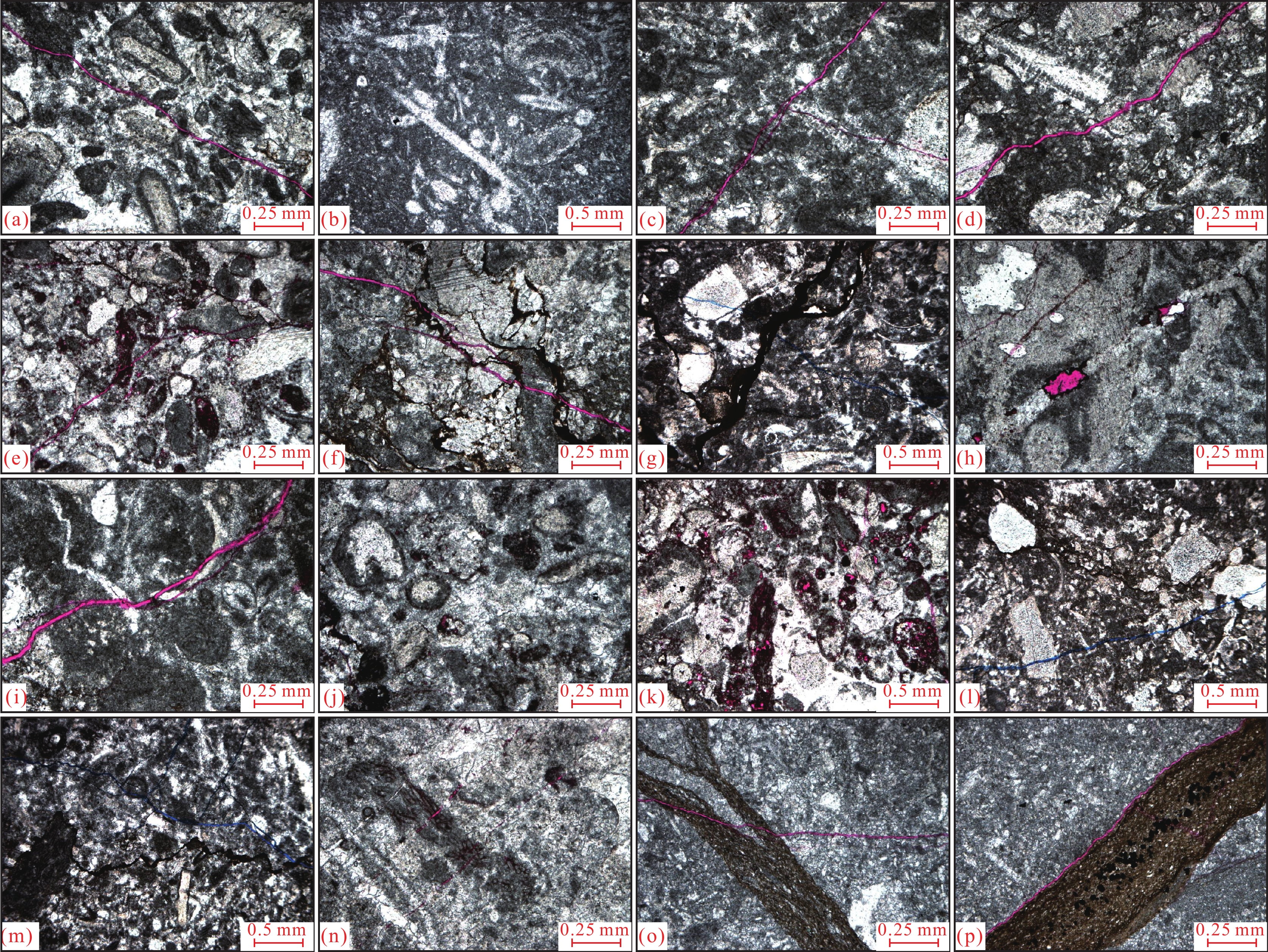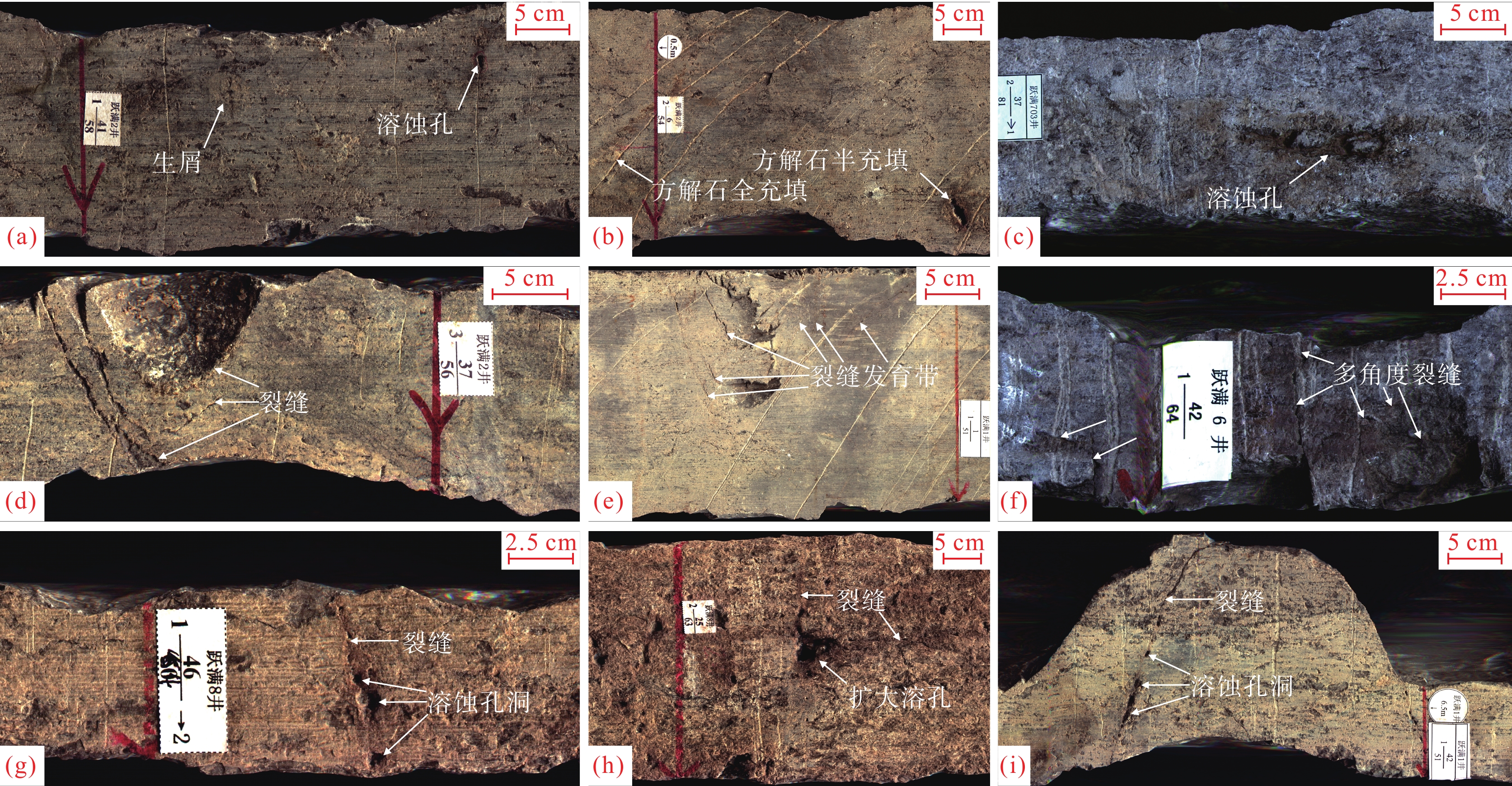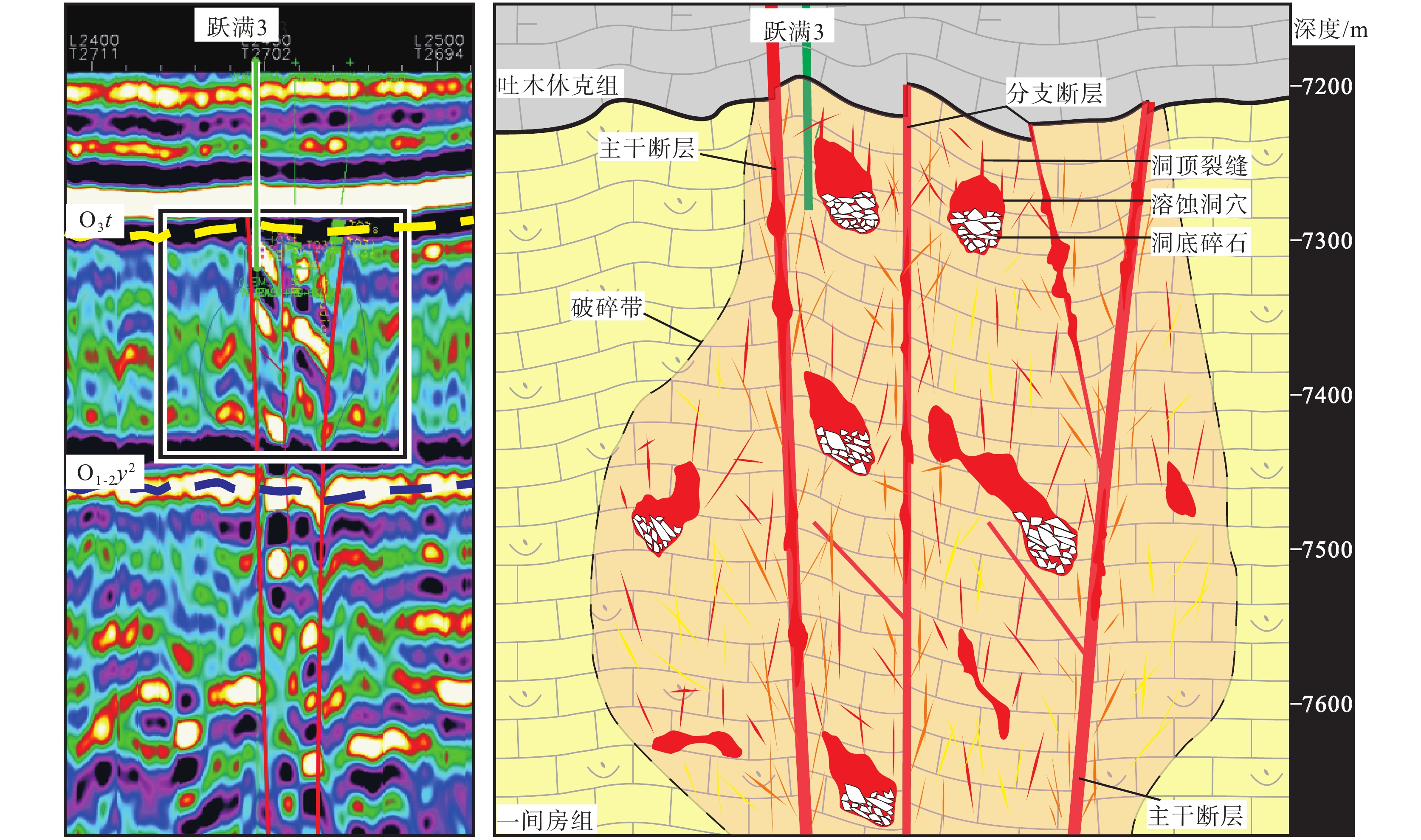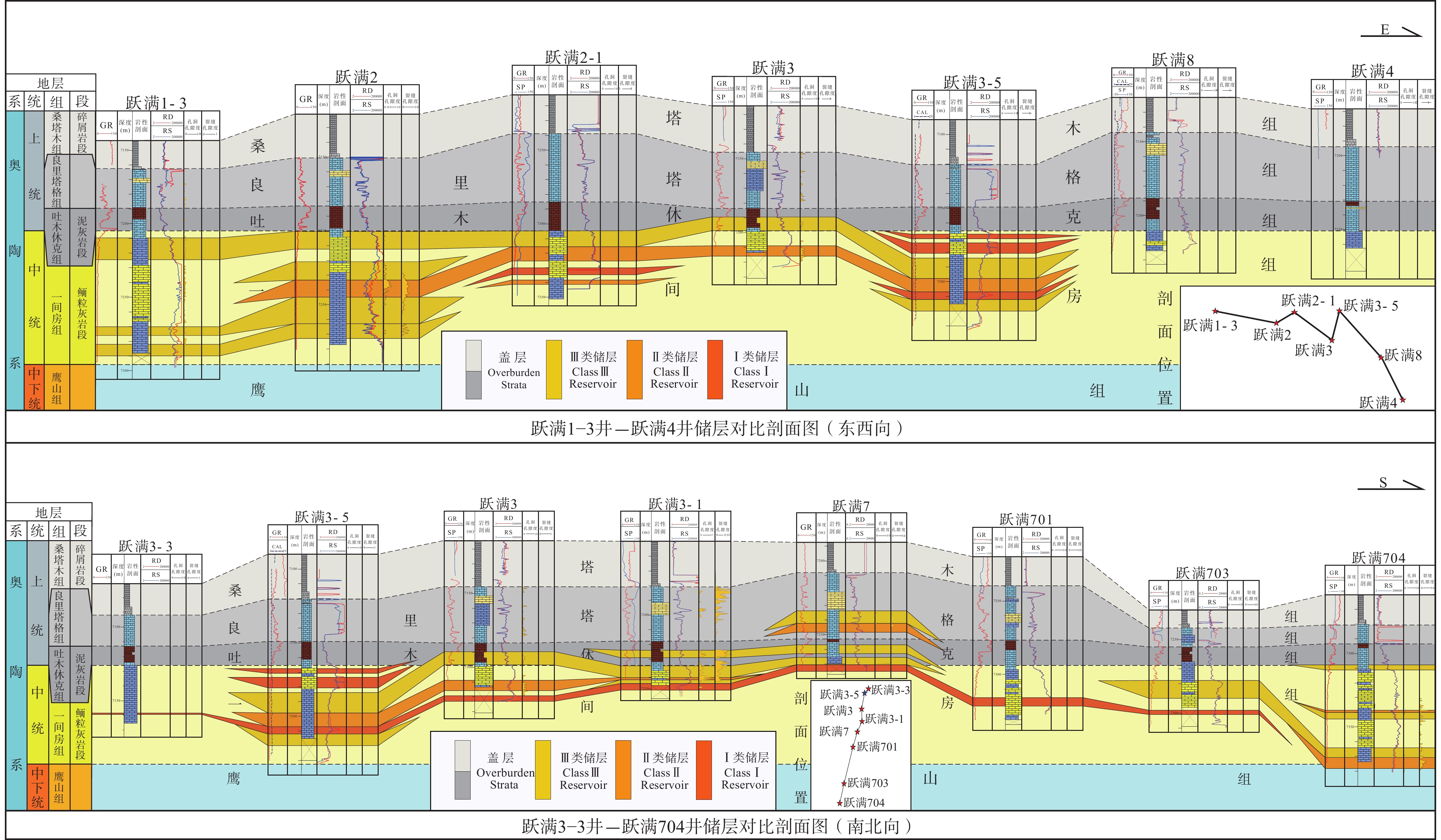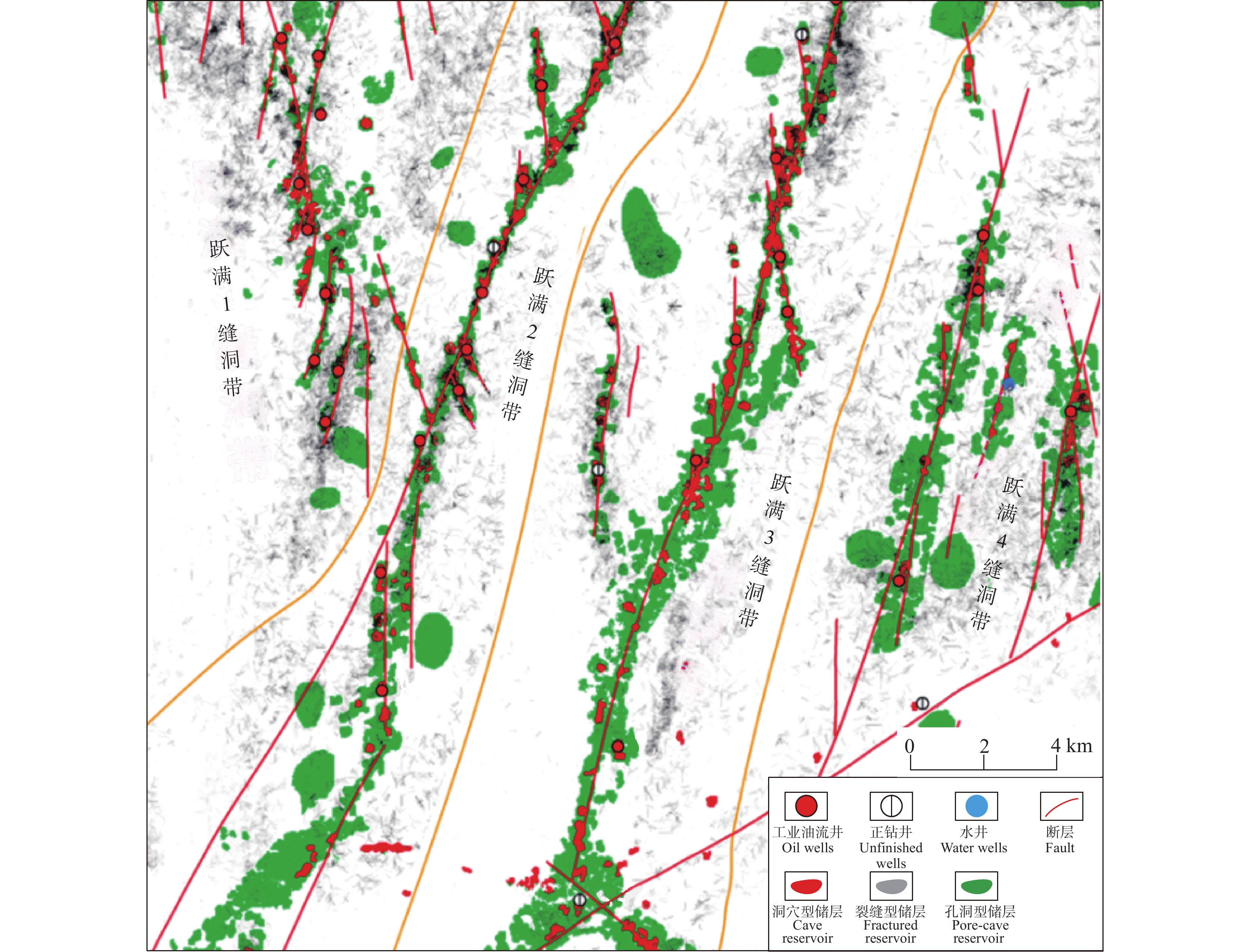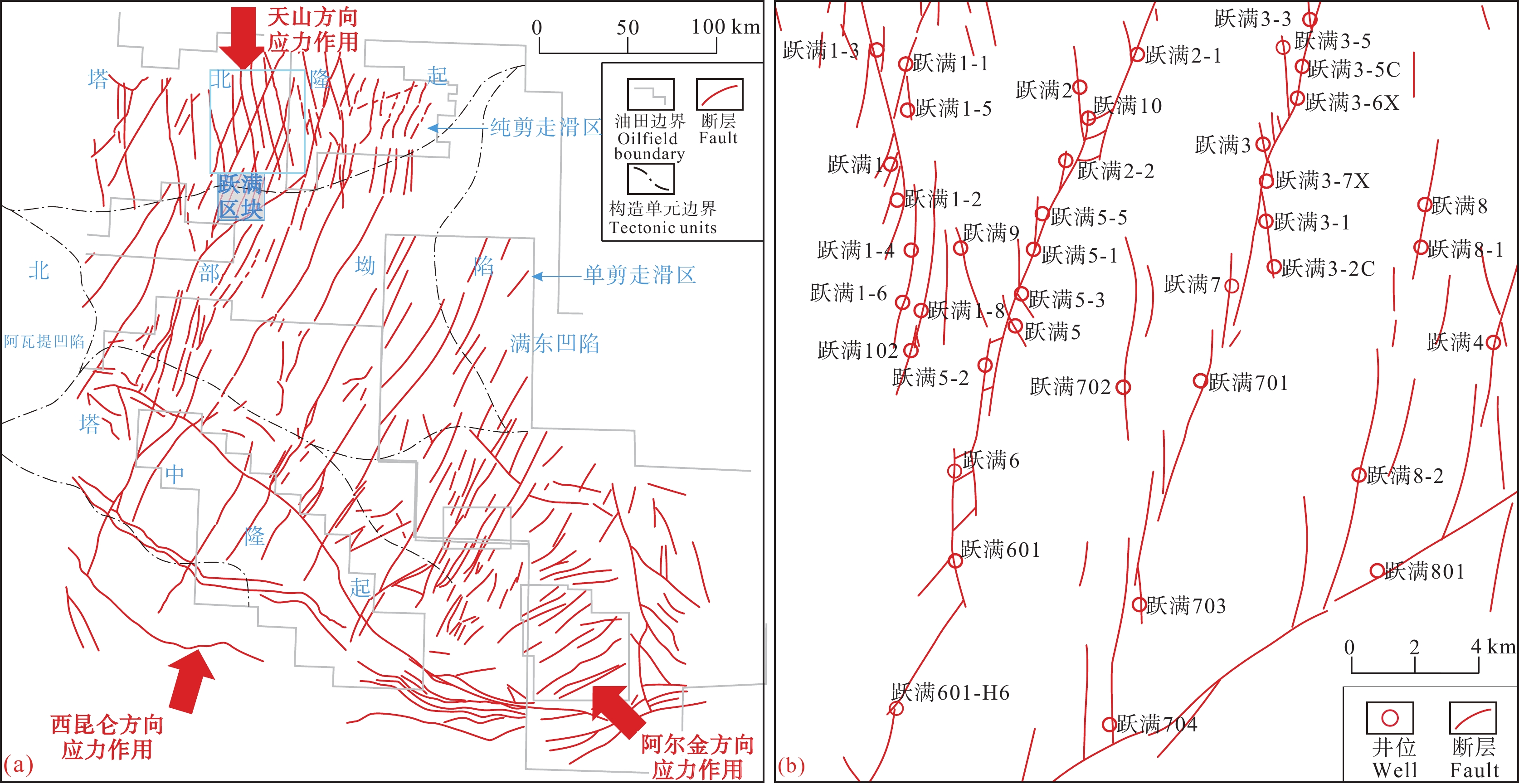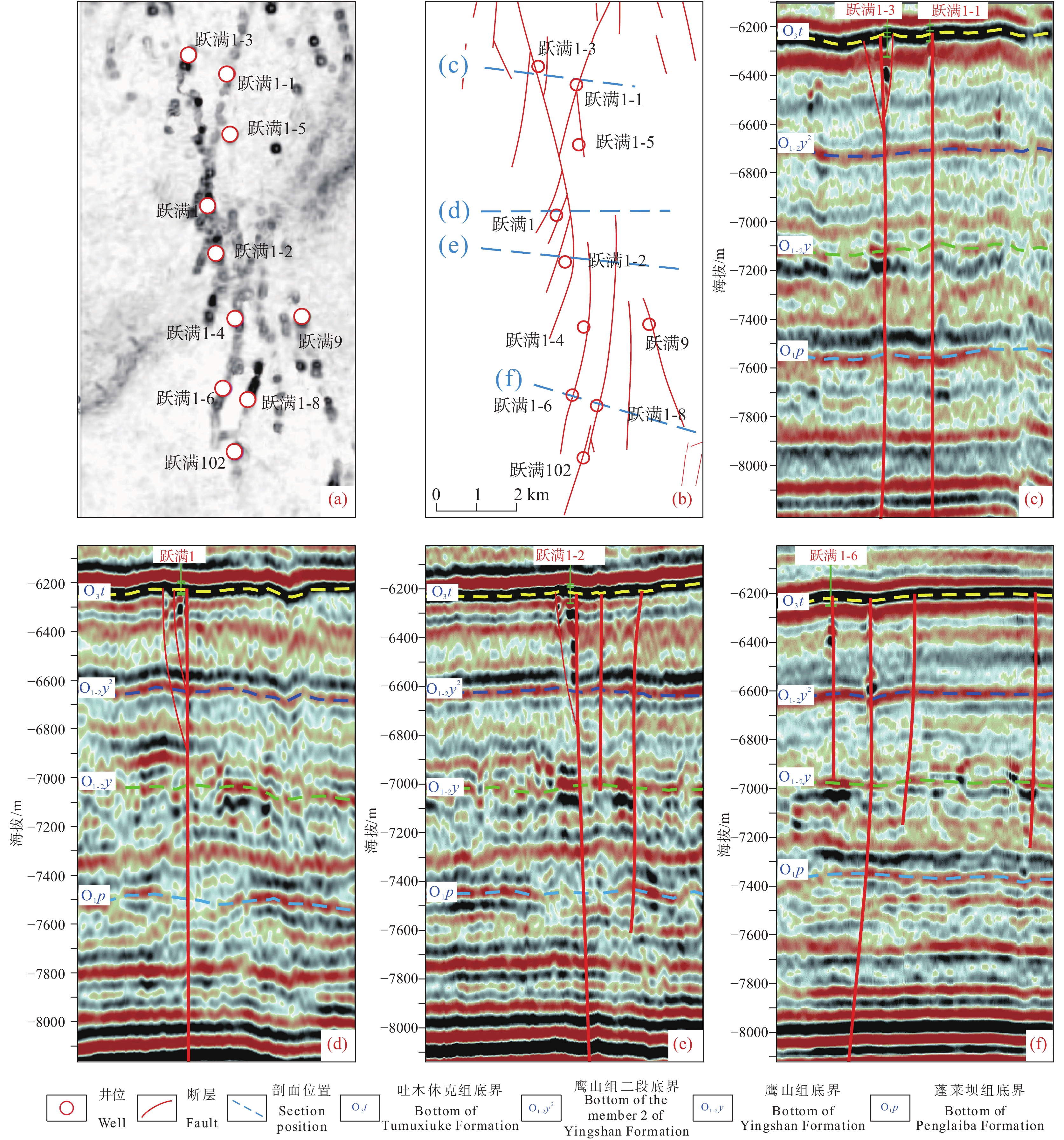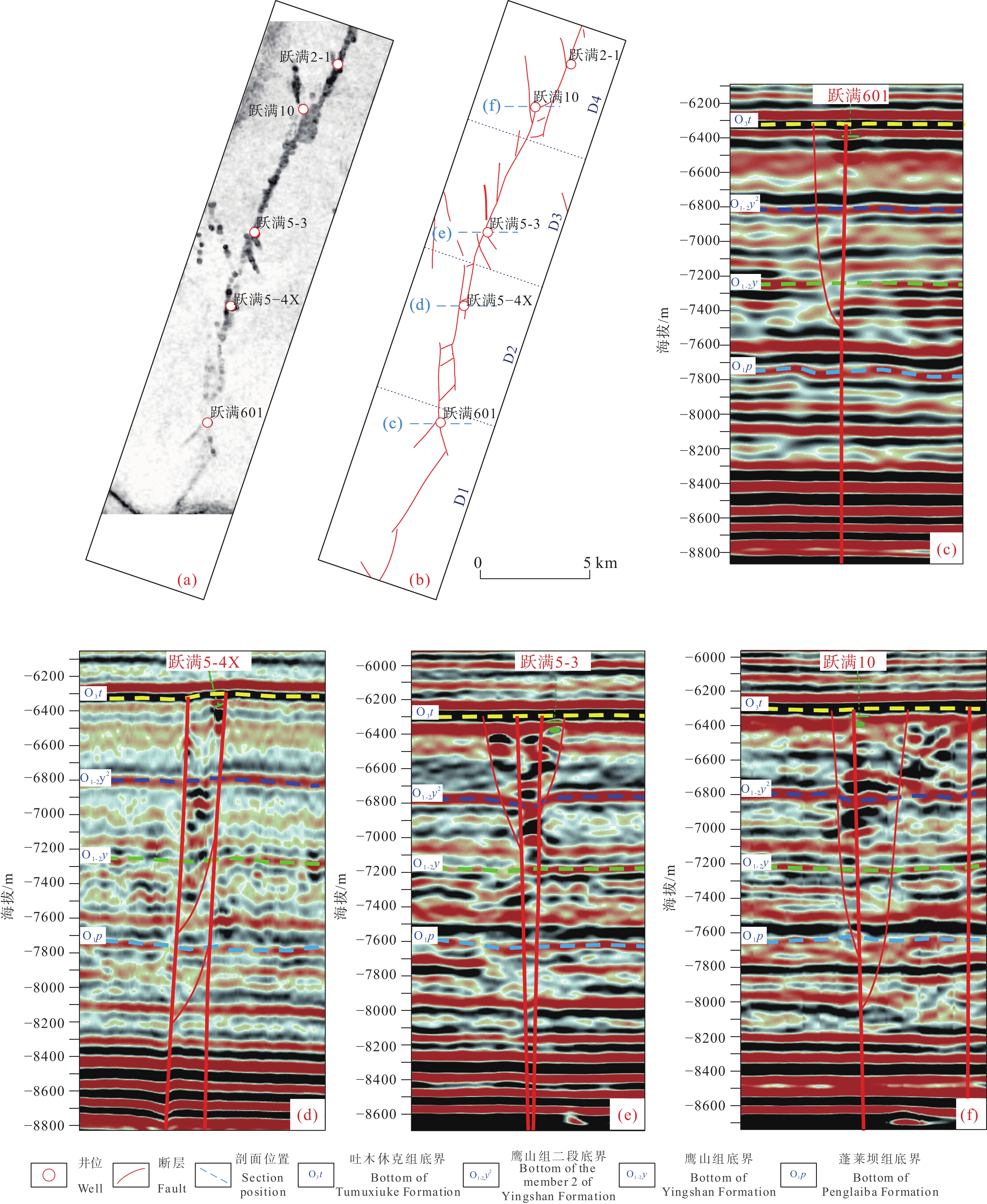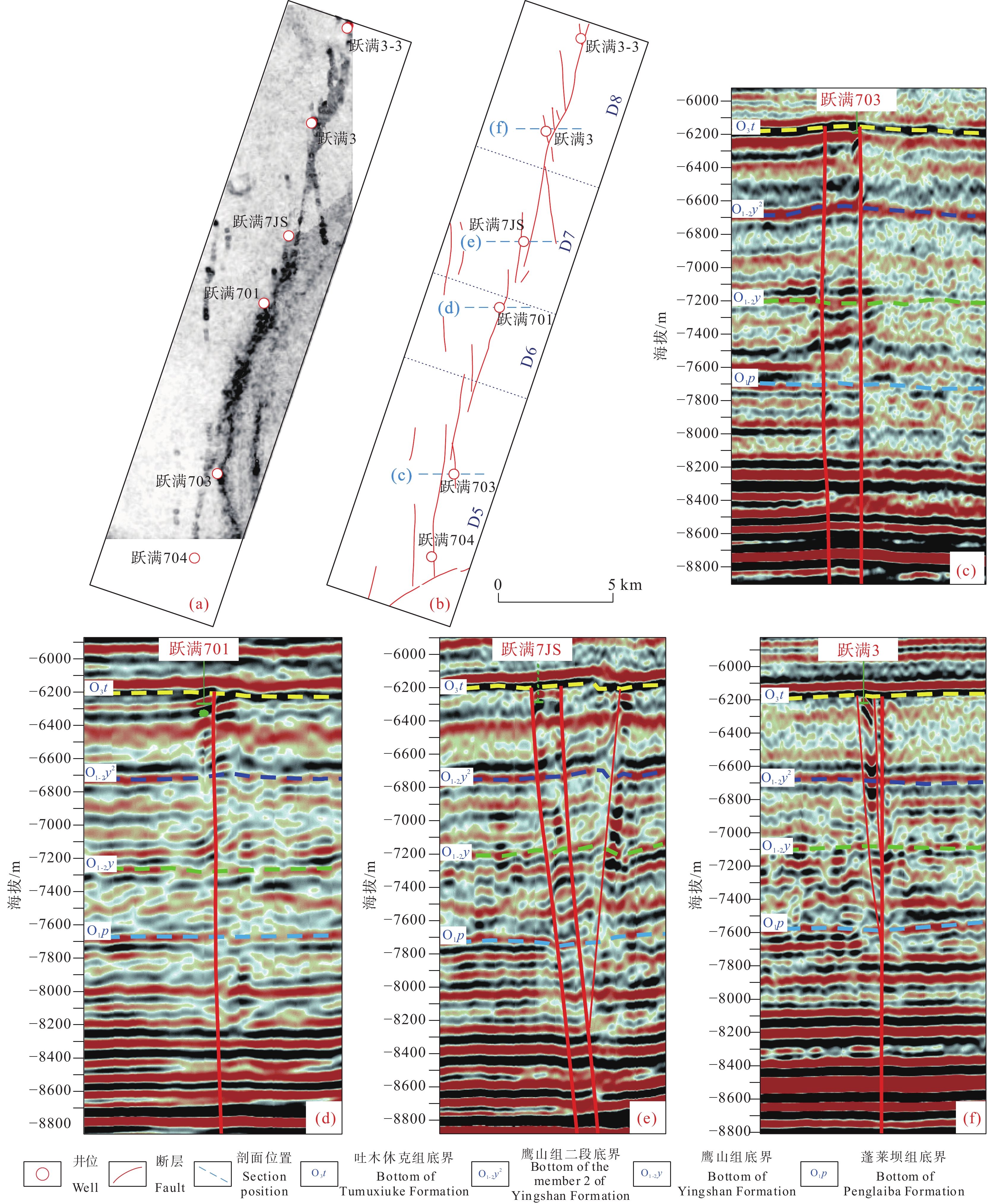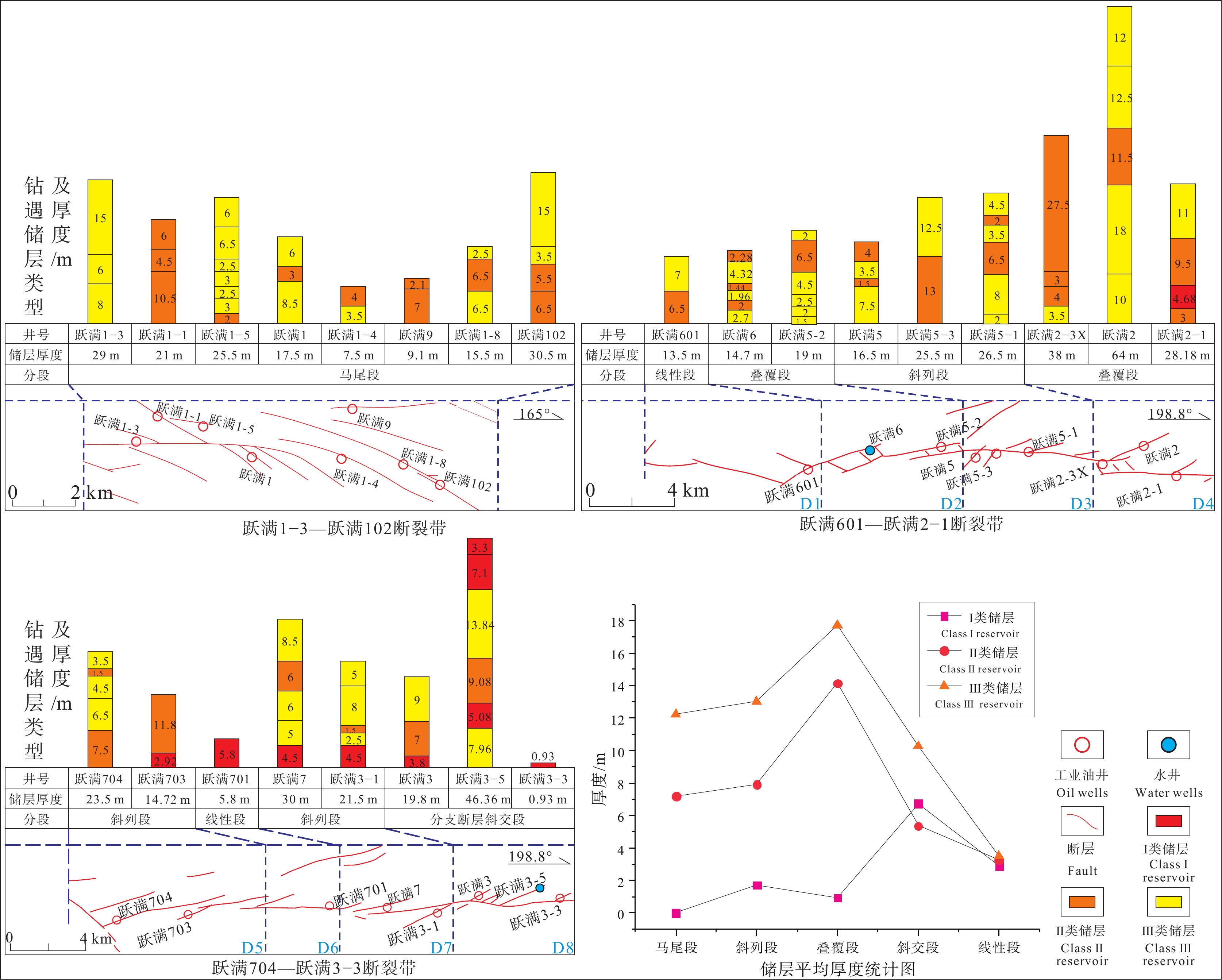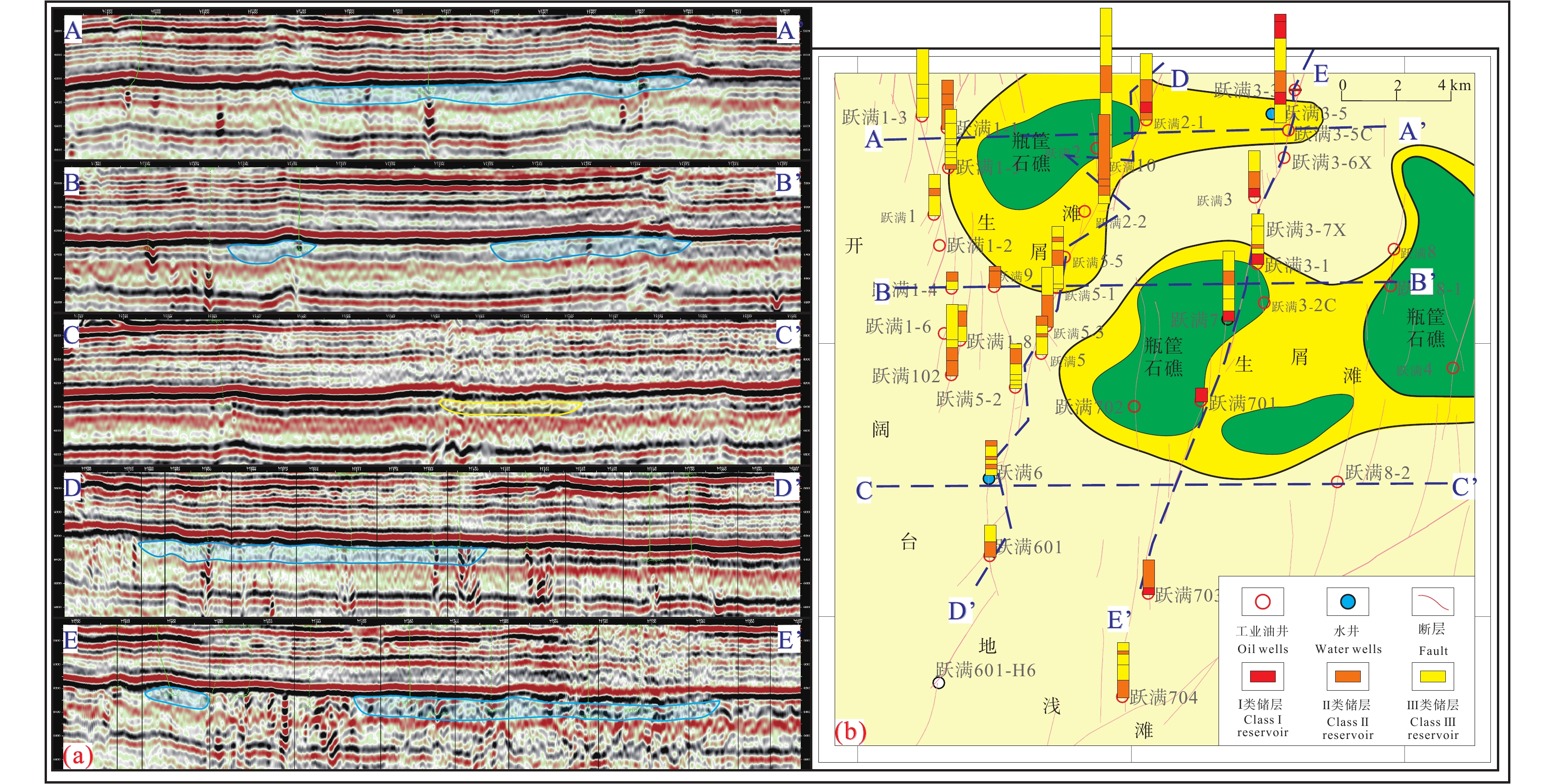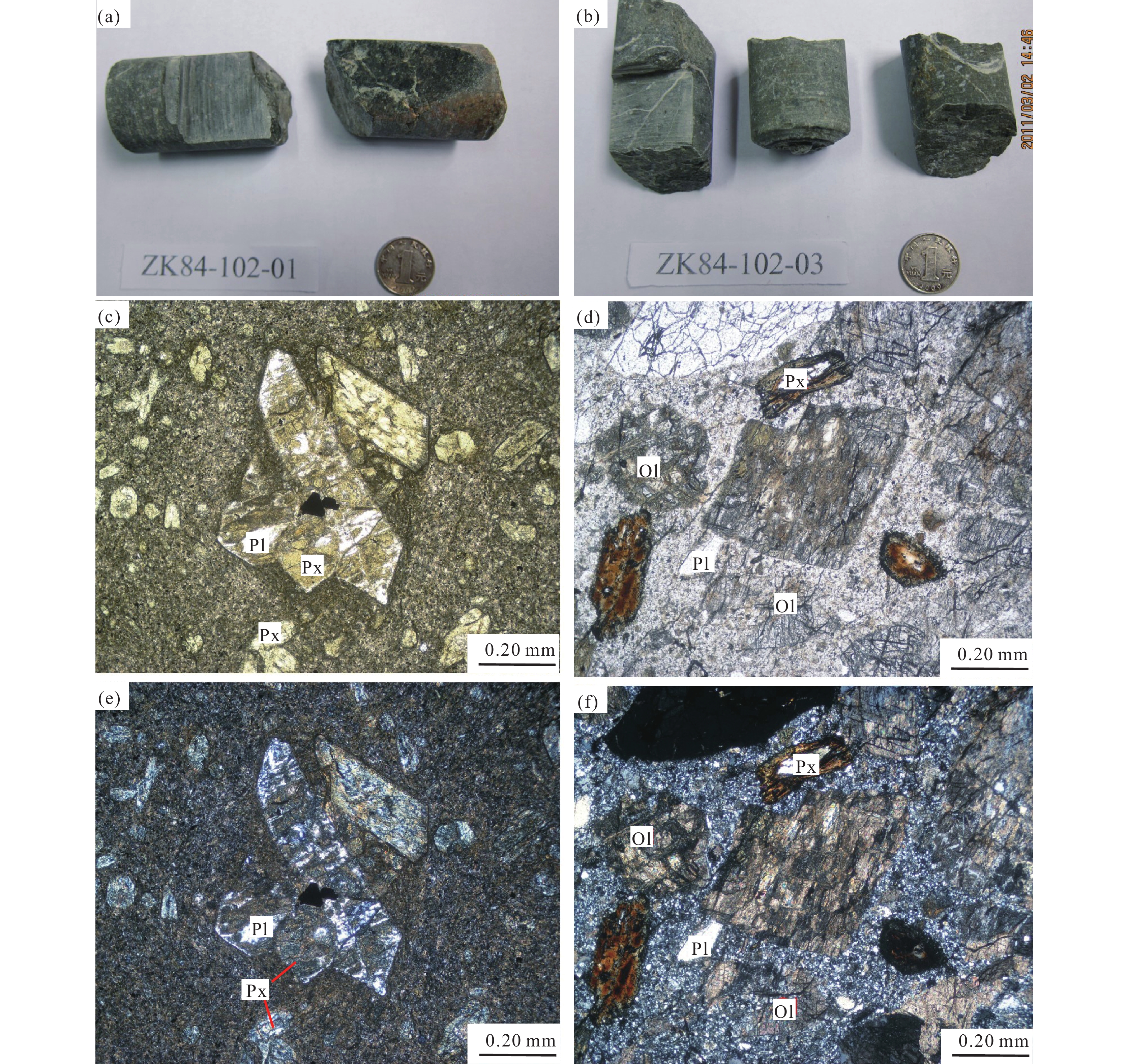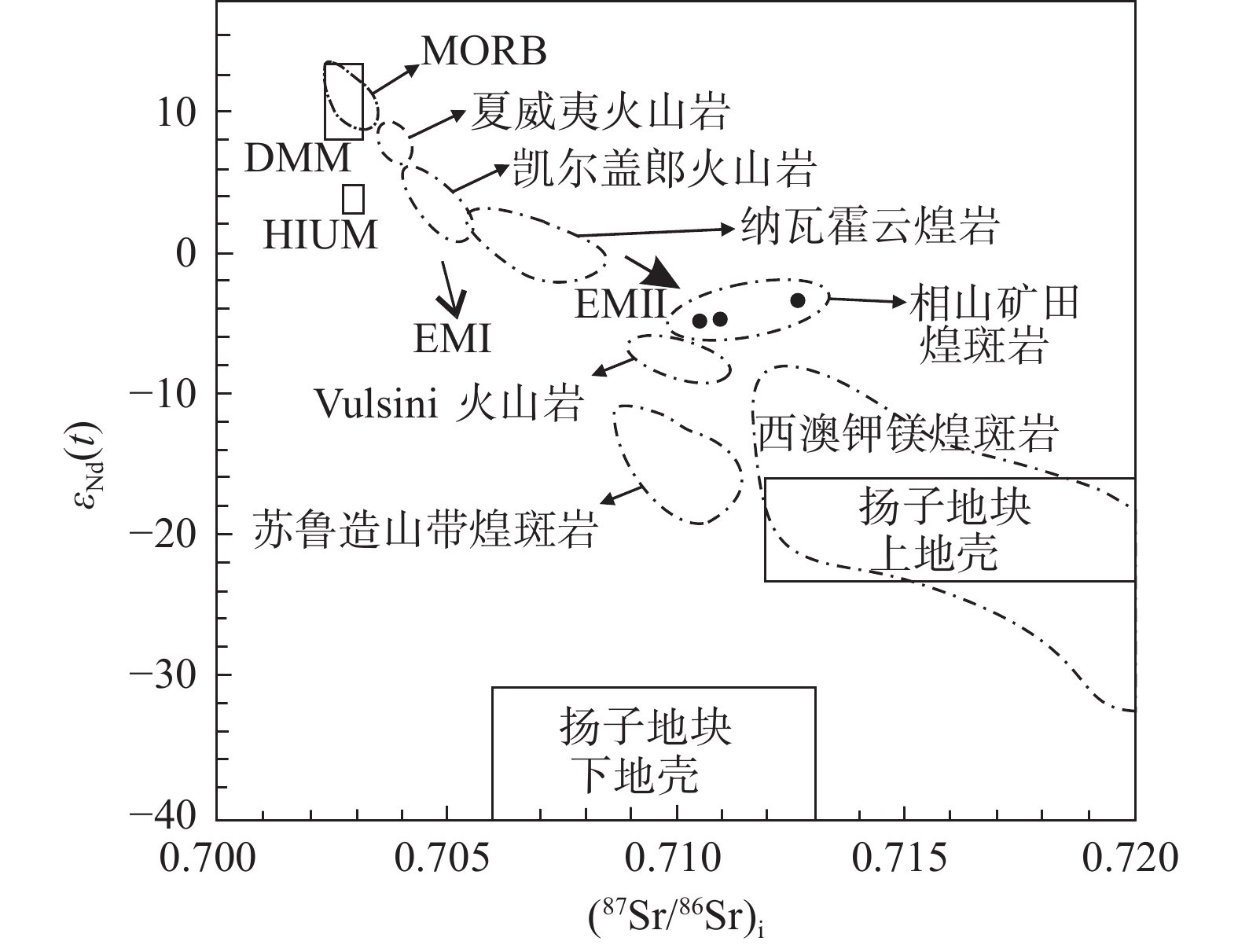Geochronology, geochemistry of lamprophyre and evidence of mantle fluid in the western part of Xiangshan uranium orefield
-
摘要:研究目的
幔源岩浆是探讨深部动力学演化和铀成矿的研究对象,相山铀矿田基性岩脉是探讨区域岩浆演化和铀成矿的关键所在。
研究方法本文对矿区西部煌斑岩脉进行了系统的岩石学、地质年代学和地球化学综合研究。
研究结果本区存在3期煌斑岩,分别为134 Ma、120~125 Ma和84.5 Ma。该区煌斑岩为钠质碱性煌斑岩,富集LILE和LREE,亏损HFSE,具明显的Ta−Nb−Ti负异常,具有岛弧玄武岩和大陆地壳的微量元素特征。该区煌斑岩为部分熔融和结晶分异共同作用的产物,经历了橄榄石、单斜辉石的结晶分异作用,在岩浆上侵过程中受到明显上地壳物质的混染。该区煌斑岩形成于伸展作用下的板内拉张构造环境,未受到古太平洋板块俯冲作用的影响。其源区应为软流圈亏损地幔与岩石圈富集地幔的混合,且主要体现为软流圈亏损地幔特征。
结论第一期煌斑岩矿岩时差大,仅为后期铀的沉淀富集提供有利条件;后两期煌斑岩矿岩时差小,不仅为相山矿田铀矿化提供了幔源流体(ΣCO2矿化剂和He),也为铀沉淀富集提供还原障。
创新点:(1)相山西部煌斑岩形成于134 Ma、120~125 Ma和84.5 Ma;(2)煌斑岩主要为软流圈亏损地幔特征;(3)第一期煌斑岩为铀沉淀富集提供有利条件,后两期煌斑岩为铀矿化提供幔源流体和还原障。
Abstract:This paper is the result of mineral exploration engineering.
ObjectiveMantle−derived magma generally provied an object to reveal geodynamic evolution in the depth and uranium mineralization. The mafic dikes in the west of Xiangshan uranium deposit are regarded as a key aspect to understand the regional tectono−magmatic evolution and uranium mineralization.
MethodsIn this paper, the comprehensive research of petrology, geochronology and geochemistry were carried on the lamprophyre in the west of Xiangshan uranium deposit.
ResultsThere are three stages of lamprophyre in this area, which are 134 Ma, 120–125 Ma and 84.5 Ma. The lamprophyre is sodium−alkaline lamprophyre and characterized with the enrichment of LILE and LREE, depletion of HFSE, and obvious negative anomaly of Ta–Nb–Ti. The lamprophyre is the product of partal melting from the source region and crystallisation differentiation, which experienced the crystallization differentiation of olivine and clinopyroxene as well as strong assimilation and contamination of upper crustal meterials during the magmatic intrusion. The lamprophyre was formed in the extentional entraplate tensioned tectonic environment, and was not affected by the subduction of the ancient Pacific Plate. The source region is a mixture of asthenospheric depleted mantle (main source) and lithospheric enriched mantle, which is mainly characterized by asthenospheric depleted mantle.
ConclusionsThe first period of lamprophyres is much older than the age of uranium mineralization, only providing favorable conditions for uranium accumulation. The later two periods of lamprophyres are closely associated with uranium deposits on space and time, possibly providing mantle hydrothemal fluids (∑CO2 and He) and a favorable reducing environment for uranium enrichment and deposition.
Highlights:(1) There are three stages of lamprophyre in this area, which are 134 Ma, 120–125 Ma and 84.5 Ma; (2) Lamprophyre is mainly characterized by asthenospheric depleted mantle; (3) The lamprophyre of the first stage provides favorable conditions for uranium precipitation enrichment, and the lamprophyre of the late two stages provides mantle source fluid and reduction barrier for uranium mineralization.
-
1. 引 言
塔里木盆地古生界碳酸盐岩储层分布广,厚度大,生储盖空间配置优越(翟光明等, 2004),围绕古隆起发育的塔北油田与塔中油田更是中国陆上碳酸盐岩油气勘探开发研究的重点区块(Yang et al., 2007; 何治亮等, 2016)。塔北油田的开发经历了自北部潜山区向南到顺层改造区的探索,形成了一套以浅层风化壳岩溶及层间岩溶为主控的缝洞体油藏的认识(沈安江等, 2019)。随着勘探开发逐步深入到台缘叠加区,已有油藏体系认知无法对低隆区油藏的开发进行有效指导,开发陷入瓶颈。随着顺北1号与顺北5号深层—超深层奥陶系碳酸盐岩储层取得重大突破(Jiao et al., 2018),受断裂控制的断溶体油气藏逐渐成为油田勘探开发的重点,对油气藏的认识也逐步转变为深大断裂控储、控藏、控富研究(王新新等, 2019; 丁志文等, 2020)。
塔里木盆地地质历史上构造运动强烈,经历多期构造运动,受区域应力场作用,稳定克拉通内部发育一系列陆内短滑距走滑断裂(Han et al., 2017; 邓尚等, 2021),最新三维地震勘探揭示,多期构造作用形成的走滑断裂继承性发育,形成多种构造样式,导致油气分布具有明显的区段性(邬光辉等, 2011)。同时,受断裂控制的断溶体油气藏特征表现出仅沿断裂带含油、且不均匀富集的特点(Wu et al., 2018; Jiao et al., 2018),表明走滑断裂是控制储层的重要因素(Wang et al., 2021),故进一步认识断裂对岩溶性储层的控制作用对碳酸盐岩油气的勘探具有重要意义。
2. 区域地质概况
跃满区块构造上位于塔里木盆地塔北隆起轮南低凸起的西部斜坡带(图1),轮南低凸起为一大型潜山背斜,面积15100 km2,主体在轮南油田至塔河油田一带,长轴在东部为北东向,西部为北东东向。跃满区块为向西倾没的哈拉哈塘大型鼻状构造一部分,北接轮台凸起,南衔北部坳陷,西邻英买力低凸起。研究区区域构造演化主要经历了中、晚加里东运动差异抬升期,晚海西—印支运动挤压抬升期,燕山—早喜山运动局部调整期,晚喜山运动至今构造反转期(马德波等, 2020)。
跃满区块地层发育完整,自上而下钻遇新生界第四系,新近系和古近系,中生界白垩系、侏罗系、三叠系,古生界二叠系、石炭系、志留系以及奥陶系。奥陶系可细分为上奥陶统桑塔木组(O3s)、良里塔格组(O3l)、吐木休克组(O3t);中奥陶统一间房组(O2y);中—下奥陶统鹰山组(O1-2y);下奥陶统蓬莱坝组(O1p)(朱光有等, 2011)。勘探开发目的层主要为奥陶系一间房组海相碳酸盐岩地层,上覆吐木休克组为一致密泥灰岩层,可以形成良好的油气封闭条件,有利于下伏一间房组油气成藏。
3. 储层特征
3.1 储层岩石学特征
岩心、薄片和测井资料表明,跃满地区中奥陶统一间房组储集岩以灰岩为主,岩性主要为生屑灰岩、砂屑灰岩、颗粒灰岩、泥晶灰岩(图2),为开阔台地相的台内砂屑、藻屑滩沉积岩类。岩心孔渗分析结果显示孔隙度平均值1.00%、渗透率平均值1.160×10−3 μm2,均为较低水平,且孔隙度与渗透率相关性不明显。
![]() 图 2 跃满地区奥陶系一间房组储层岩性(染色铸体薄片)a—跃满2井,井深:7211.8 m,亮晶生屑灰岩,构造缝;b—跃满2井,井深:7200.6 m,泥晶生屑灰岩;c—跃满2井,井深:7209.7 m,泥亮晶生屑灰岩,构造缝;d—跃满2井,井深:7206.7 m,泥粉晶生屑灰岩,构造缝;e—跃满2井,井深:7215.7 m,亮晶藻团块生屑灰岩,构造缝;f—跃满2井,井深:7209.9 m,泥亮晶生屑灰岩,构造缝与压溶缝;g—跃满2井,井深:7201.7 m,泥晶生屑灰岩,构造缝,压溶缝;h—跃满2井,井深:7210.7 m,方解石和沥青质半充填的构造缝;i—跃满2井,井深:7207.3 m,亮晶藻砂屑灰岩,构造缝,方解石全充填的溶蚀缝;j—跃满2井,井深:7216.7 m,亮晶生屑藻砂屑灰岩,粒内溶孔;k—跃满2井,井深:7217.6 m,泥亮晶生屑藻砂屑灰岩,粒内溶孔;l—跃满2井,井深:7212.6 m,亮晶颗粒灰岩,构造缝,压溶缝;m—跃满2井,井深:7213.7 m,亮晶颗粒灰岩,构造缝,压溶缝;n—跃满2井,井深:7214.5 m,粉晶颗粒灰岩,方解石半充填构造缝;o—跃满2井,井深:7196.5 m,生屑泥晶灰岩,构造缝;p—跃满2井,井深:7197.5 m,生屑泥晶灰岩,收缩缝Figure 2. Reservoir lithology of Ordovician Yijianfang Formation in Yueman area (dyed cast thin section)a−Well Yueman 2, depth: 7211.8 m, sparry bioclastic limestone, structural fracture; b−Well Yueman 2, depth: 7200.6 m, micrite bioclast limestone; c−Well Yueman 2, depth: 7209.7 m, micrite−sparry bioclast limestone, structural fracture; d−Well Yueman 2, depth: 7206.7 m, micrite−powder bioclast limestone, structural fracture; e−Well Yueman 2, depth: 7215.7 m, sparry clumpy alga bioclastic limestone, structural fracture; f−Well Yueman 2, depth: 7209.9 m, micrite−sparry bioclast limestone, structural fracture, pressolutional fracture; g−Well Yueman 2, depth: 7201.7 m, micrite bioclast limestone, structural fracture, pressolutional fracture; h−Well Yueman 2, depth: 7210.7 m, structural fracture, half−filled with calcite and asphalt; i−Well Yueman 2, depth: 7207.3 m, sparry algal arenaceous limestone, structural fracture, dissolution fracture, full−filled with calcite; j−Well Yueman 2, depth: 7216.7 m, Sparry bioclastic arenaceous limestone, intragranular dissolved pore; k−Well Yueman 2, depth: 7217.6 m, argillaceous sparry bioclastic arenaceous limestone, intragranular dissolved pore; l−Well Yueman 2, depth: 7212.6 m, sparry granular limestone, structural fracture, pressolutional fracture; m−Well Yueman 2, depth: 7213.7 m, sparry granular limestone, structural fracture, pressolutional fracture; n−Well Yueman 2, depth: 7214.5 m, silt−grained limestone, half−filled with calcite, structural fracture ; o−Well Yueman 2, depth: 7196.5 m, bioclastic micritic limestone, structural fracture; p−Well Yueman 2, depth: 7197.5 m, bioclastic micritic limestone, shrinkage fracture
图 2 跃满地区奥陶系一间房组储层岩性(染色铸体薄片)a—跃满2井,井深:7211.8 m,亮晶生屑灰岩,构造缝;b—跃满2井,井深:7200.6 m,泥晶生屑灰岩;c—跃满2井,井深:7209.7 m,泥亮晶生屑灰岩,构造缝;d—跃满2井,井深:7206.7 m,泥粉晶生屑灰岩,构造缝;e—跃满2井,井深:7215.7 m,亮晶藻团块生屑灰岩,构造缝;f—跃满2井,井深:7209.9 m,泥亮晶生屑灰岩,构造缝与压溶缝;g—跃满2井,井深:7201.7 m,泥晶生屑灰岩,构造缝,压溶缝;h—跃满2井,井深:7210.7 m,方解石和沥青质半充填的构造缝;i—跃满2井,井深:7207.3 m,亮晶藻砂屑灰岩,构造缝,方解石全充填的溶蚀缝;j—跃满2井,井深:7216.7 m,亮晶生屑藻砂屑灰岩,粒内溶孔;k—跃满2井,井深:7217.6 m,泥亮晶生屑藻砂屑灰岩,粒内溶孔;l—跃满2井,井深:7212.6 m,亮晶颗粒灰岩,构造缝,压溶缝;m—跃满2井,井深:7213.7 m,亮晶颗粒灰岩,构造缝,压溶缝;n—跃满2井,井深:7214.5 m,粉晶颗粒灰岩,方解石半充填构造缝;o—跃满2井,井深:7196.5 m,生屑泥晶灰岩,构造缝;p—跃满2井,井深:7197.5 m,生屑泥晶灰岩,收缩缝Figure 2. Reservoir lithology of Ordovician Yijianfang Formation in Yueman area (dyed cast thin section)a−Well Yueman 2, depth: 7211.8 m, sparry bioclastic limestone, structural fracture; b−Well Yueman 2, depth: 7200.6 m, micrite bioclast limestone; c−Well Yueman 2, depth: 7209.7 m, micrite−sparry bioclast limestone, structural fracture; d−Well Yueman 2, depth: 7206.7 m, micrite−powder bioclast limestone, structural fracture; e−Well Yueman 2, depth: 7215.7 m, sparry clumpy alga bioclastic limestone, structural fracture; f−Well Yueman 2, depth: 7209.9 m, micrite−sparry bioclast limestone, structural fracture, pressolutional fracture; g−Well Yueman 2, depth: 7201.7 m, micrite bioclast limestone, structural fracture, pressolutional fracture; h−Well Yueman 2, depth: 7210.7 m, structural fracture, half−filled with calcite and asphalt; i−Well Yueman 2, depth: 7207.3 m, sparry algal arenaceous limestone, structural fracture, dissolution fracture, full−filled with calcite; j−Well Yueman 2, depth: 7216.7 m, Sparry bioclastic arenaceous limestone, intragranular dissolved pore; k−Well Yueman 2, depth: 7217.6 m, argillaceous sparry bioclastic arenaceous limestone, intragranular dissolved pore; l−Well Yueman 2, depth: 7212.6 m, sparry granular limestone, structural fracture, pressolutional fracture; m−Well Yueman 2, depth: 7213.7 m, sparry granular limestone, structural fracture, pressolutional fracture; n−Well Yueman 2, depth: 7214.5 m, silt−grained limestone, half−filled with calcite, structural fracture ; o−Well Yueman 2, depth: 7196.5 m, bioclastic micritic limestone, structural fracture; p−Well Yueman 2, depth: 7197.5 m, bioclastic micritic limestone, shrinkage fracture3.2 储层类型
薄片、岩心及钻测井资料揭示(图2,图3;表1),研究区奥陶系碳酸盐岩储集空间宏观上以大型溶蚀洞穴、溶蚀孔洞及构造裂缝为主,微观上以孔隙(粒间孔、粒内孔、晶间孔、晶间溶孔)与微裂缝(构造缝、压溶缝、溶蚀缝)为主。根据洞、孔、缝组合特征,储层类型可分为洞穴型储层、裂缝−孔洞型储层、裂缝型储层与孔洞型储层4类,其中洞穴型储层储集能力最强,裂缝孔洞型储层兼具良好的储集与运移能力,分别为区内重点开发的Ⅰ类、Ⅱ类储层发育段,而裂缝型与孔洞型储层储集能力一般但分布广,多为Ⅲ类储层发育段。
![]() 图 3 跃满地区奥陶系一间房组储层类型(岩心)a—跃满2井,1−58−35,生屑砂屑灰岩,溶蚀孔洞;b—跃满2井,2−54−6,生屑砂屑灰岩,溶蚀孔洞,方解石全充填、半充填;c—跃满703井,2−81−37,生屑灰岩,溶蚀孔洞;d—跃满2井,3−56−37,砂屑生屑灰岩,中高角度缝;e—跃满1井,1−51−1,砂屑灰岩,中高角度缝,沿缝发育溶蚀孔;f—跃满6井,1−64−42,砂屑灰岩,直立缝与水平缝近垂直共轭;g—跃满8井,1−64−46,砂屑灰岩,高角度裂缝,沿裂缝溶蚀孔洞发育,见油斑;h—跃满8井,2−63−25,砂屑灰岩,直立缝与水平缝交汇处溶孔扩大;i—跃满1井,1−51−42,砂屑灰岩,中高角度裂缝,沿裂缝溶蚀孔洞发育Figure 3. Reservoir type of the Yijianfang Formation of Ordovician in Yueman area (cores)a−Well Yueman 2, 1−58−35, bioclastic calcarenite, dissolved pore; b−Well Yueman 2, 2−54−6, bioclastic calcarenite, dissolved pore, full filled or half filled with calcite; c−Well Yueman 703, 2−81−37, bioclastic limestone, dissolved pore; d−Well Yueman 2, 3−56−37, sandy bioclastic limestone, middle−high angle fracture; e−Well Yueman 1, 1−51−1, calcarenite, middle−high angle fracture, dissolved pore; f−Well Yueman 6, 1−64−42, calcarenite, horizontal and vertical fractures; g−Well Yueman 8, 1−64−46, calcarenite, high Angle fracture, dissolved pore, oil patch; h−Well Yueman 8, 2−63−25, calcarenite, horizontal and vertical fractures, dissolved pore increase at fracture intersections; i−Well Yueman 1, 1−51−42, calcarenite, middle−high angle fracture, dissolved pore表 1 跃满区块漏失统计Table 1. Lost circulation statistics in Yueman area
图 3 跃满地区奥陶系一间房组储层类型(岩心)a—跃满2井,1−58−35,生屑砂屑灰岩,溶蚀孔洞;b—跃满2井,2−54−6,生屑砂屑灰岩,溶蚀孔洞,方解石全充填、半充填;c—跃满703井,2−81−37,生屑灰岩,溶蚀孔洞;d—跃满2井,3−56−37,砂屑生屑灰岩,中高角度缝;e—跃满1井,1−51−1,砂屑灰岩,中高角度缝,沿缝发育溶蚀孔;f—跃满6井,1−64−42,砂屑灰岩,直立缝与水平缝近垂直共轭;g—跃满8井,1−64−46,砂屑灰岩,高角度裂缝,沿裂缝溶蚀孔洞发育,见油斑;h—跃满8井,2−63−25,砂屑灰岩,直立缝与水平缝交汇处溶孔扩大;i—跃满1井,1−51−42,砂屑灰岩,中高角度裂缝,沿裂缝溶蚀孔洞发育Figure 3. Reservoir type of the Yijianfang Formation of Ordovician in Yueman area (cores)a−Well Yueman 2, 1−58−35, bioclastic calcarenite, dissolved pore; b−Well Yueman 2, 2−54−6, bioclastic calcarenite, dissolved pore, full filled or half filled with calcite; c−Well Yueman 703, 2−81−37, bioclastic limestone, dissolved pore; d−Well Yueman 2, 3−56−37, sandy bioclastic limestone, middle−high angle fracture; e−Well Yueman 1, 1−51−1, calcarenite, middle−high angle fracture, dissolved pore; f−Well Yueman 6, 1−64−42, calcarenite, horizontal and vertical fractures; g−Well Yueman 8, 1−64−46, calcarenite, high Angle fracture, dissolved pore, oil patch; h−Well Yueman 8, 2−63−25, calcarenite, horizontal and vertical fractures, dissolved pore increase at fracture intersections; i−Well Yueman 1, 1−51−42, calcarenite, middle−high angle fracture, dissolved pore表 1 跃满区块漏失统计Table 1. Lost circulation statistics in Yueman area序号 井号 放空长/m 漏失量/m3 序号 井号 放空长/m 漏失量/m3 1 跃满1 1.92 355 18 跃满5−4X 6.39 659 2 跃满10 0 506.12 19 跃满5−5 1.85 148.4 3 跃满1−1 0 535.7 20 跃满601 0 373.7 4 跃满1−3 0.12 118.24 21 跃满6C 0 215.5 5 跃满1−5 0.76 0 22 跃满701 0 260.4 6 跃满2−2C 0 1200 23 跃满701−H1 1.11 1494.4 7 跃满2−4X 1.41 2049 24 跃满702 0 133.2 8 跃满3 0 253.4 25 跃满703 2.72 252.2 9 跃满3−1 1.49 307.1 26 跃满7−1X 0 1558.11 10 跃满3−2C 0 1063.2 27 跃满7−2X 0.34 1527.19 11 跃满3−3 0.93 348.5 28 跃满7JS 19.1 3231.33 12 跃满3−5 0.74 114.6 29 跃满8 4.02 773.5 13 跃满3−5C 8 1064.6 30 跃满801 2.79 1389.18 14 跃满3−6X 0.96 241.6 31 跃满801−H6 2.59 549.4 15 跃满3−7X 0 9.9 32 跃满802 1.45 329.7 16 跃满4 0 43.8 33 跃满8−1 6.34 286.2 17 跃满5−3 0 269.4 34 跃满9 9.25 811 孔洞型、裂缝型、裂缝−孔洞型储层在区内大量发育。其中孔洞型储层以一间房组开阔台地相台内滩和台地边缘相台缘礁滩体等高能相带为发育基础,层状发育且具有较好的孔隙度与渗透率,储层段岩心薄片可见微观粒间溶孔、铸膜孔、粒内溶孔等(图2e、k),可见部分孔洞被方解石充填,岩心可见不规则溶蚀孔洞发育,部分被方解石半充填、全充填(图3a~c)。裂缝型储层区内普遍发育,连通溶蚀洞穴、孔洞或成组发育的裂缝型储层更为有效,薄片可见沥青与泥质全充填的压溶缝,方解石全充填、半充填的溶蚀缝,未充填的构造缝等(图2f、h、i);岩心显示裂缝以中高角度—高角度构造缝为主,形态总体较规则,缝面较平坦,具成组发育特征(图3d~f)。裂缝−孔洞型储层主要分布于一间房组开阔台地相台内滩颗粒灰岩中,兼具良好的运移与储集能力,岩心显示,沿裂缝溶蚀孔洞发育,且多裂缝交汇处溶蚀孔洞发育更佳(图3g~i)。
洞穴型储层以大型溶蚀洞穴为主要储集空间,洞穴围岩裂缝及洞底碎石孔隙为次要储集空间,新三维地震资料显示,洞穴在地震剖面上表现出强串珠状反射特征,该类储层主要发育于一间房组上部,沿主干断层或断层两侧垂向发育(图4)。
钻井资料上洞穴型储层表现为放空和漏失,跃满区块已有钻井的放空漏失现象统计显示,区内共完钻51口井,放空21井,占比41.2%,平均放空3.537 m,最长放空跃满7JS井,放空长达19.1 m,最短放空跃满1−3井,仅放空0.12 m;同时总计33井有漏失现象,占比64.7%,平均漏失681.0 m3,最小漏失跃满3−7X井共9.9 m3,最大漏失跃满7JS井共3231 m3(表1),放空漏失现象普遍。
3.3 储层发育规律
综合钻、测井及三维地震资料,对比东西向与南北向相邻井所揭示的岩性、储层及沉积特征,对区内储层分布特征进行厘定,结果表明,在垂向上,储层主要分布于一间房组顶面以下0~120 m范围之内,少量钻井(跃满3、跃满7)揭示上覆吐木休克组与良里塔格组有少量Ⅱ类和Ⅲ类储层发育;在横向剖面上,储层表现出强非均质性以及低连续性:各井储层类型、储层厚度差异较大,东西向连井对比图显示各井储层连续性差,而在近南北断层走向上,连井对比图显示储层具有一定连续性(图5);在一间房组,洞穴型储层沿断裂孤立发育,孔洞型储层与裂缝型储层沿断裂带状发育,同时,不同断裂构造段内储层发育具有显著差异性,特别是洞穴型储层,往往集中于局部断裂大量发育,显示出强烈的断控特征(图6)。
4. 走滑断裂特征
塔里木盆地经历多期不同方向的斜向构造挤压作用,盆内发育多组走滑断裂系统,按形成的力学机制可分为纯剪机制和单剪机制(图7)。研究区受古昆仑洋及阿尔金板块俯冲消解作用,形成多组纯剪机制的“X”型共轭走滑断裂带(Tang et al., 2012; 孙东等, 2015),在此基础上,共轭断层相继滑动、切割调节,形成的不连续断层经过尾端扩张与连接生长,最终形成位移量极少的“小位移”长断裂带。通过断裂带碳酸盐胶结物U−Pb测年结合地震解析,确定塔里木盆地奥陶系碳酸盐岩走滑断裂活动始于距今约460 Ma的中奥陶世末期(Wu et al., 2021)。跃满区块位于塔北哈拉哈塘地区南部,为共轭走滑断裂发育区的边缘地带,区内主要发育一组北北西向与三组北北东向走滑断裂(图7)。
![]() 图 7 塔北至塔中地区(a,据Wu et al., 2021修改)跃满区块(b)走滑断裂体系纲要图Figure 7. Schematic diagram of strike−slip faults in Tabei−Tazhong area (a, modified from Wu et al., 2021) and Yueman area (b)
图 7 塔北至塔中地区(a,据Wu et al., 2021修改)跃满区块(b)走滑断裂体系纲要图Figure 7. Schematic diagram of strike−slip faults in Tabei−Tazhong area (a, modified from Wu et al., 2021) and Yueman area (b)4.1 走滑断裂分段特征
北北西向跃满1−3—跃满102断裂带位于跃满区块西北部,为北部金跃地区向南延伸的一号断裂的末端,具有强烈的应力发散特点,研究区可见有另一北北东向走滑断裂(跃满1−1井所在断裂)终止于该马尾断层。北北东向跃满601—跃满2−1断裂带与跃满704—跃满3−3断裂带位于研究区中部,是研究区油气开发的重点,两条断裂均延伸较长,跃满601—跃满2−1断裂带向南延伸至顺北区块后终止,向北穿过金跃、热普等区块,延伸至哈6区块被共轭北北西向断裂截断;跃满704—跃满3−3断裂带向南终止于北东东向的顺北1号断裂带,向北延伸至金跃区块后被截断。跃满801—跃满8走滑断裂仅在研究区发育,延伸较短、连续性差且前期勘探开发尚不完善,故暂不做分析研究。
在对区内沿断裂走向的高度差异表征断层应力特征研究的基础上,对断裂构造进行分段性研究,结果显示:跃满1−3—跃满102断裂带为一典型马尾段,平面上由主干断层与若干同向弯曲的短分支断层组成,分支断层向南散开形成典型的马尾状构造,最南端转变为扇形排布的雁列断层,地震剖面上,北部可见平行的主干断层与小的花状构造,中部可见半花状构造,南部多为深大半花状构造(图8)。
跃满601—跃满2−1断裂带自南向北可划分四段:D1线性段、D2叠覆段、D3斜列段、D4叠覆段。D1线性段为压扭性质,平面上为单条断层线性延伸,剖面上为单条直立断层;D2与D4左行右阶叠覆段均为张扭性质,平面上表现为主干断层错位发育,在断层之间形成条形叠覆区域,叠覆区内受拉张应力作用,发育多条与两主干断层大角度斜交的分支断层,D2段一大一小两个叠覆区连续发育,D4段叠覆区规模居中,剖面上主要表现为两条直立断层伴随半花状构造;D3斜列段中部为压扭性质,靠近叠覆段的两端为张扭性质,平面上由多条断层平行排列组成,剖面上主要表现为两条直立断层(图9)。
跃满704—跃满3−3断裂带自南向北可划分为四段:D5斜列段、D6线性段、D7斜列段、D8斜交段。D5斜列段为压扭性质,D7斜列段为张扭性质,平面上均为多条断层平行排列,与断层整体走向呈低角度交错,剖面上为两条直立断层;D6线性段为D5斜列段至D7斜列段间的过渡段,为张扭性质,平面上为单条主干断层,剖面上为单条陡直断层;D8斜交式断层应力性质表现为压扭与张扭交错,平面上为若干R剪切分支断层与主干断层组成,分支断层主要发育于主干断层以西,剖面上显示为发育在奥陶系内的半花状构造(图10)。
4.2 各构造段储层分布特征
根据三维地震资料揭示的洞穴及缝洞雕刻结果,区内布置并完成了30余口井的钻探工作,并对27口井进行了试采,在钻测井资料对储层的解析基础上,结合走滑断裂的分段特征对断裂不同构造段内储层发育情况进行统计分析(表2,表3,表4),结果表明:马尾段内,储层厚度普遍较厚,储层类型以裂缝型与孔洞型储层为主,裂缝孔洞型储层少量发育,未见洞穴型储层,储层发育整体较好;叠覆段与斜列段内,储层厚度普遍较厚,且各类储层均有发育,储层发育最佳;分支断层斜交段储层发育极不均匀,整体认为储层发育一般;线性段储层发育则普遍较差。
表 2 跃满区块钻井储层统计(跃满1−3—跃满102)Table 2. Reservoir statistics of drilling in Yueman area (Yueman 1−3−Yueman 102)分段 井号 顶深/m 底深/m 层厚/m 类型 顶深/m 底深/m 层厚/m 类型 马尾段 跃满1−3 7209 7224 15 Ⅲ 7282 7290 8 Ⅲ 7270 7276 6 Ⅲ 跃满1−1 7217 7223 6 Ⅱ 7227.5 7238 10.5 Ⅱ 7223 7227.5 4.5 Ⅱ 跃满1−5 7226 7232 6 Ⅲ 7287 7289.5 2.5 Ⅲ 7255 7261.5 6.5 Ⅲ 7295.5 7298.5 3 Ⅲ 7275.5 7278 2.5 Ⅲ 7301.5 7303.5 2 Ⅱ 7282.5 7285.5 3 Ⅲ 跃满1 7259.5 7265.5 6 Ⅲ 7268.5 7277 8.5 III 7265.5 7268.5 3 II 跃满1−4 7297 7301 4 Ⅱ 7303.5 7307 3.5 Ⅲ 跃满9 7586.8 7588.9 2.1 Ⅱ 7591 7598 7 Ⅱ 跃满1−8 7302.5 7305 2.5 Ⅲ 7343.5 7350 6.5 Ⅲ 7311 7317.5 6.5 Ⅱ 跃满102 7282 7297 15 Ⅲ 7300.5 7306 5.5 Ⅱ 7297 7300.5 3.5 Ⅲ 7306 7312.5 6.5 Ⅱ 表 4 跃满区块钻井储层统计(跃满704—跃满3−3)Table 4. Reservoir statistics of drilling in Yueman area (Yueman 704−Yueman 3−3)分段 井号 顶深/m 底深/m 层厚/m 类型 顶深/m 底深/m 层厚/m 类型 斜列段 跃满704 7307.5 7311 3.5 Ⅲ 7364 7370.5 6.5 Ⅲ 7338.5 7340 1.5 Ⅱ 7370.5 7378 7.5 Ⅱ 7340 7344.5 4.5 Ⅲ 跃满703 7277.9 7289.7 11.8 Ⅲ 7298 7300.92 2.92 Ⅰ 线性段 跃满701 7315.7 7321.5 5.8 Ⅰ 斜列段 跃满7 7234 7242.5 8.5 Ⅲ 7265.5 7270.5 5 Ⅲ 7242.5 7248.5 6 II 7270.5 7275 4.5 Ⅰ 7257 7263 6 Ⅲ 跃满3−1 7224 7229 5 Ⅲ 7244 7246.5 2.5 Ⅲ 7234.5 7242.5 8 Ⅲ 7246.5 7251 4.5 Ⅰ 7242.5 7244 1.5 Ⅱ 分支断层
斜交段跃满3 7189.5 7198.5 9 Ⅲ 7219.4 7223.2 3.8 Ⅰ 7209 7216 7 Ⅱ 跃满3−5 7167.7 7171 3.3 Ⅰ 7197.88 7206.96 9.08 Ⅱ 7173.8 7180.9 7.1 Ⅰ 7206.96 7212.04 5.08 Ⅰ 7184.04 7197.88 13.84 Ⅲ 7212.04 7220 7.96 Ⅲ 跃满3−3 7158.62 7159.55 0.93 Ⅰ 表 3 跃满区块钻井储层统计(跃满601—跃满2−1)Table 3. Reservoir statistics of drilling in Yueman area (Yueman 601−Yueman 2−1)分段 井号 顶深/m 底深/m 层厚/m 类型 顶深/m 底深/m 层厚/m 类型 线性段 跃满601 7313 7320 7 Ⅲ 7372.5 7379 6.5 Ⅱ 叠覆段 跃满6 7294 7296.28 2.28 Ⅱ 7302.04 7304 1.96 Ⅲ 7296.28 7300.6 4.32 Ⅲ 7304 7306 2 Ⅱ 7300.6 7302.04 1.44 Ⅱ 7308 7310.7 2.7 Ⅲ 跃满5−2 7277 7279 2 Ⅲ 7301.5 7304 2.5 Ⅲ 7284 7290.5 6.5 Ⅱ 7313 7315 2 Ⅲ 7290.5 7295 4.5 Ⅲ 7318 7319.5 1.5 Ⅲ 斜列段 跃满5 7272.5 7276.5 4 Ⅱ 7280 7281.5 1.5 Ⅱ 7276.5 7280 3.5 Ⅲ 7281.5 7289 7.5 Ⅲ 跃满5−3 7258.5 7271 12.5 Ⅲ 7279 7292 13 Ⅱ 跃满5−1 7248.5 7253 4.5 Ⅲ 7263 7269.5 6.5 Ⅱ 7253 7255 2 Ⅱ 7269.5 7277.5 8 Ⅲ 7255 7258.5 3.5 Ⅲ 7280.5 7282.5 2 Ⅲ 叠覆段 跃满2−3X 7274 7301.5 27.5 Ⅱ 7319 7323 4 Ⅱ 7313 7316 3 Ⅱ 7323 7326.5 3.5 Ⅲ 跃满2 7200.5 7212.5 12 Ⅲ 7245 7263 18 III 7221 7233.5 12.5 Ⅲ 7263 7273 10 Ⅲ 7233.5 7245 11.5 Ⅱ 跃满2−1 7304.5 7315.5 11 Ⅲ 7329.76 7334.44 4.68 Ⅰ 7315.5 7325 9.5 Ⅱ 7338 7341 3 Ⅱ 5. 分析讨论
5.1 断控岩溶作用对储层发育的控制
综上所述,跃满区块走滑断裂分段特征与储层的发育规模具有一定的耦合关系,前人研究认为:塔北哈拉哈塘地区岩溶作用对碳酸盐岩储层具有直接控制作用(Dan et al., 2016; 梁乘鹏等, 2019),岩溶体系又主要受控于低水位期海平面下降、先存断裂及裂缝、地表河流体系(Liang and Jones, 2014; 宁超众等, 2020)。塔北奥陶系碳酸盐岩储层发育可分为四个阶段:一间房组准同生阶段、良里塔格组台缘滩沉积阶段、志留系前潜山岩溶阶段与后期埋藏溶蚀阶段(张学丰等, 2012; 赵学钦等, 2015),而非暴露区跃满区块位于塔北隆起最南缘,隆升幅度最小(廖涛等, 2016),故该区奥陶系储层主要受早期准同生岩溶与后三期埋藏岩溶作用,埋藏岩溶作用主要表现为深部溶蚀性流体沿断裂向上运移,改造一间房组碳酸盐岩,形成有效储集体(郑剑等, 2015; 牛君等, 2017)。分析认为断裂主要通过控制岩溶作用间接控制储层的发育,结合钻井与走滑断裂相对位置关系发现:区内储层发育程度受控于走滑断裂的构造样式及应力特征,构造样式越复杂,应力作用越集中,则岩溶作用更强,相应储层发育更好(图11)。
马尾段是断裂端部应力发散的结果,多条拉张性质的雁列断层与分支断层成组发育,整体构造样式较复杂,中部短马尾分支断层间距小、下切浅,南部长雁列断层间距大、下切深。断层间距越小,单位面积溶蚀作用则越强,而下切越深越有利于溶蚀性流体的上侵,马尾段储层统计显示,整体储层发育较好,平均厚度19.45 m,储层类型多为裂缝型、孔洞型以及裂缝−孔洞型,未见洞穴型储层发育。
斜列段与叠覆段均为应力集中区,且区内构造样式复杂,斜列的主干断层以及连通主干断层的分支断层均可作为流体的运移通道,溶蚀区域面积增大且溶蚀作用强度大幅增强,以主干断层夹持区溶蚀效果最好。区内钻井揭示,区内斜列段与叠覆段储层发育最佳,储层厚度均较厚,各井平均厚度23.46 m,最厚储层38 m(跃满2−3X井),最薄储层14.7 m(跃满6井),储层类型以裂缝孔洞型为主,各井均有多类储层发育。
分支断层斜交段局部应力集中,密集程度不一,多条分支断层逆向发育于断层西侧,分支断层长度不一,与马尾段类似,长分支断层具有更长的流体运移通道,分支断层密集区单位面积溶蚀作用更强,储层统计显示长分支断层储层厚度异常厚,例如跃满3−5井,储层厚46.36 m,各类储层均发育,短分支断层上储层发育一般,且非密集分支断层上的跃满3−3井储层发育极差,整体认为储层发育一般。
线性段均无构造应力集中,且构造样式简单,断层仅作为流体的运移通道,岩溶作用对该段内碳酸盐岩改造作用较弱。线性段内储层发育较差,厚度较薄且储层类型单一。
5.2 断控高能相带对储层发育的控制
研究区一间房组整体为开阔台地相,加里东中期—晚奥陶纪早期(加里东中期Ⅰ幕),塔北发生了一次较大规模的海退,一间房组短暂暴露,准同生岩溶大面积发育(倪新锋等, 2009),中奥陶世末期,走滑断裂开始活动并控制着区内微地貌(Wu et al., 2021),断裂挤压段易形成正地貌,有利于高能礁滩体发育,该类礁滩体受准同生期岩溶作用及自身结构影响,具有更好的孔隙度、渗透率(Zeng et al., 2018; 高达等, 2022),也更易受埋藏岩溶作用溶蚀改造,从而形成有效储集体。
新三维地震资料上不同沉积相带具有不同的地震响应特征:开阔台地相地震反射时差横向变化稳定,成平行、亚平行结构,振幅较强、连续,能量稳定;台内滩地震反射时差增大,反射杂乱,具有下超、上隆的特征,振幅变弱(聂杞连等, 2015)。连井地震剖面显示,区内一间房组顶部发育不规则的高能相带(图12),主要覆盖了跃满601—跃满2−1断裂带北部D3斜列段与D4叠覆段,跃满704—跃满3−3断裂带中北部D6线性段与D7斜列段。对比高能相带叠合区与非叠合区发现,在断裂分段性控制储层发育的基础上,高能相带的叠加区储层发育更好,与高能相带叠加的D4叠覆段相较D2叠覆段储层厚度更厚,叠加高能相带的D3斜列段和D7斜列段储层厚度相近,且储层厚度均高于D5斜列段。
6. 结 论
(1)跃满区块奥陶系一间房组储层发育,储集岩以生屑灰岩、砂屑灰岩、颗粒灰岩、泥晶灰岩为主。根据储集空间组合特征储层可分为洞穴型储层、裂缝−孔洞型储层、裂缝型储层和孔洞型储层四类。各类储层集中发育于一间房组顶部,沿走滑断裂带状分布。
(2)跃满区块位于塔北南坡纯剪走滑区,发育一组北北西向与三组北北东向走滑断裂。区内断裂具有分段性,按平面构造样式可分为马尾段、斜列段、叠覆段、分支断层斜交段和线性段。断裂不同段内平面组合特征、剖面构造特征和应力特征均有区别,马尾段应力发散,构造样式复杂,斜列段与叠覆段应力集中、构造样式复杂,分支断层斜交段局部应力集中、构造样式单一,线性段无构造应力集中,构造样式最简单。
(3)走滑断裂分段性影响埋藏岩溶作用强度及规模,从而控制储层发育程度与分布情况。研究区内马尾段、斜列段和叠覆段储层发育最佳,分支断层斜交段储层发育受控于分支断层长度,整体发育一般,线性段储层发育较差。此外,在断裂分段性控制储层发育的基础上,高能相带叠加区储层更为发育。
致谢: 项目研究过程中,中国石油塔里木油田勘探开发研究院的张银涛高级工程师、康鹏飞工程师,以及西南石油大学地球科学与技术学院的赵星星、崔晓庆、宋玉婷等在前期资料收集、数据处理上提供了指导和帮助,审稿专家与编辑对稿件提出了宝贵的修改意见。在此一并致以诚挚谢意!
-
图 1 相山火山−侵入杂岩地质略图(据张万良, 2015)
1—第四系黏土;2—上白垩统砂岩、砂砾岩;3—下白垩统鹅湖岭组碎斑熔岩;4—下白垩统鹅湖岭组晶屑凝灰岩、砂砾岩;5—下白垩统打鼓顶组流纹英安岩;6—下白垩统打鼓顶组砂岩、熔结凝灰岩;7—上三叠统石英砂岩、页岩;8—中元古界片岩、千枚岩;9—加里东期花岗岩;10—花岗斑岩;11—断裂;12—矿床;13—取样位置
Figure 1. Geological sketch map of Xiangshan volcanic-intrusive complex (after Zhang Wanliang, 2015)
1–Quarternary clay; 2–Upper Cretaceous sandstone and glutenite; 3–Porphyroclastic lava in Ehuling Formation of Lower Cretaceous; 4–Crystal tuff and glutenite in Ehuling Formation of Lower Cretaceous; 5–Rhyodacite in Daguding Formation of Lower Cretaceous; 6–Ignimbrite and sandstone in Daguding Formation of Lower Cretaceous; 7–Upper Triassic sandstone and shale; 8–Mesoproterozoic schist and phyllite; 9–Caledonian granite; 10–Granite−porphyry; 11–Fractures; 12–Deposits; 13–Sampling locations
图 3 相山矿田煌斑岩SiO2–(Na2O+K2O)图(a,据Rock, 1987)和K/(K+Na)–K/Al(b,据路凤香等, 1991)
CAL—钙碱性煌斑岩;UML—超基性煌斑岩;AL—碱性煌斑岩;LL—钾镁煌斑岩
Figure 3. SiO2–(Na2O+K2O) (a, after Rock, 1991) and K/(K+Na)–K/Al (b, after Lu Fengxiang et al., 1991) diagrams of lamprophyres in Xiangshan orefield
CAL–Calc–alkaline lamprophyre; UML–Ultramafic lamprophyre; AL–Alkaline lamprophyre; LL–Lamproite
图 4 煌斑岩原始地幔标准化微量元素蛛网图(a,标准化数据值据Sun and McDonough, 1989)和球粒陨石标准化REE配分模式图(b,标准化数据值据Boynton, 1984)
Figure 4. Primitive mantle−normalized spider diagrams of trace elements (a, normalization values after Sun and McDonough, 1989) and chondrite−normalized REE patterns of the lamprophyres (b, normalization values after Boynton, 1984)
图 5 相山矿田煌斑岩同化混染判别图解207Pb/204Pb–206Pb/204Pb图解(a)和208Pb/204Pb–206Pb/204Pb图解(b)(据Zartman and Doe, 1981)
DMM—亏损型地幔;EMI—I型富集地幔;EMII—II型富集地幔;NHRL—北半球参考线;Geochron—地球等时线
Figure 5. 207Pb/204Pb–206Pb/204Pb (a) and 208Pb/204Pb–206Pb/204Pb (b) diagrams of lamprophyres in Xiangshan orefield (after Zartman and Doe, 1981)
DMM–Depleted mantle; EMI−Enriched mantle I; EMII–Enriched mantle II; NHRL–Northern hemisphere reference line; Geochron–Geochronology line
图 6 相山矿田煌斑岩Th/Nb–Nb/Yb图解(a)和(Nb/Th)PM–(Th/Yb)PM图解(b)
数据来源:N–MORB和OIB据Sun and McDonough, 1989;上地壳据Taylor and McLennan, 1985;N–MORB—N型洋脊玄武岩;E–MORB—E型洋脊玄武岩;OIB—洋岛玄武岩
Figure 6. Th/Nb–Nb/Yb (a) and (Nb/Th)PM–(Th/Yb)PM (b) diagrams for lamprophyres in Xiangshan orefield
Data sources: N–MORE and OIB after Sun and McDonough, 1989; Upper crust after Taylor and McLennan, 1985; N–MORB–N–type mid–oceanic ridge basalt; E–MORB–E–type mid–oceanic ridge basalt; OIB–Oceanic island basalt
图 8 相山矿田煌斑岩构造环境判别图解
a—Zr/Y–Zr图解(据Pearce, 1982);b—Th/Yb–Ta/Yb图解(据Pearce, 1982);c—Hf/3–Th–Nb/16图解(据Wood, 1980);d—Hf/3–Th–Ta图解(据Wood, 1980);WPB—板内玄武岩;MORB—洋中脊玄武岩;IAB—岛弧玄武岩;TH—拉斑系列;TR—过渡系列;ALK—碱性系列;IAT—岛弧拉斑系列;ICA—岛弧钙碱性系列;SHO—岛弧橄榄玄武岩系列;N–MORB—N型洋脊玄武岩;E–MORB—E型洋脊玄武岩;WPT—板内拉斑玄武岩;WPA—板内碱性玄武岩
Figure 8. Tectonic environmental discrimination diagrams of lamprophyres in Xiangshan orefield
a−Zr/Y–Zr diagram (after Pearce, 1982); b−Th/Yb–Ta/Yb diagram (after Pearce, 1982); c−Hf/3–Th–Nb/16 diagram (after Wood, 1980); d−Hf/3–Th–Ta diagram (after Wood, 1980); WPB–Within plate basalt; MORB–Mid–oceanic ridge basalt; IAB–Island arc basalt; TH–Tholeiitic series; TR–Transitional series; ALK–Alkaline series; IAT–Island arc tholeiitic series; ICA–Island arc calc–alkaline series; SHO–Island arc shoshonite series; N–MORB–N-type mid-oceanic ridge basalt; E–E–type mid–oceanic ridge basalt; WPT–Within plate tholeiite; WPA–Within plate calc-alkaline basalt
图 9 相山矿田煌斑岩的(87Sr/86Sr)i–εNd(t)图解
资料来源:EMⅠ、EMⅡ、HIUM和DMM地幔单元组分(Zindler and Hart, 1986; Hart, 1988);MORB、夏威夷火山岩和凯尔盖郎火山岩(White and Hofmann, 1982);钠尔霍云煌岩(Alibert et al., 1986);Vulsini火山岩(Roger et al., 1985);西澳钾镁煌斑岩(Fraser et al., 1985);苏鲁造山带煌斑岩(Guo et al., 2004; Ma et al., 2014);扬子地块上地壳和下地壳(Gao et al., 1999)
Figure 9. (87Sr/86Sr)i versus εNd(t) diagram for the lamprophyres in Xiangshan orefield
Data resources: EMⅠ, EMⅡ, HIUM and DMM mantle components (Zindler and Hart, 1986; Hart, 1988); MORB, Hawaiian volcanic and Kerguelen volcanic rocks (White and Hofmann, 1982); Nacreoides minette (Alibert et al., 1986); Vulsini volcanic rocks (Roger et al., 1985); Lamproite from western Australia (Fraser et al., 1985); Lamprophyre from Sulu Orogenic Belt (Guo et al., 2004; Ma et al., 2014); Upper and lower crust of the Yangtze Block (Gao et al., 1999)
表 1 煌斑岩取样位置
Table 1 Sampling locations of larmprophyre
序号 样品编号 样品位置 孔号 孔深/m 1 ZK1−2−301 ZK56-102 477.50~478.30 2 ZK1−2−303 479.05~479.80 3 ZK1−2−301 ZK52-23 483.85~484.75 4 ZK1−2−303 485.70~486.65 5 ZK1−2−307 287.25~288.15 6 ZK1−2−311 291.00~291.90 7 ZK1−2−301 ZK56-101 298.00~298.30 8 ZK1−2−303 298.60~299.00 9 ZK1−2−301 ZK84-102 448.20~448.40 10 ZK1−2−303 448.60~448.80 表 2 相山矿田煌斑岩全岩K−Ar稀释法年龄测试结果
Table 2 Results of whole−rock K−Ar ages of lamprophyres with the dilutional method in Xiangshan orefield
序号 样品编号 岩性 40K/10−2 40Ar/10−6 40Ar/40K 空氩/10−2 年龄/Ma 活动期次 1 ZK1−2−303 煌斑岩 2.310 0.013860 0.005028 13.0 84.5 第三期 2 ZK1−2−303 煌斑岩 1.120 0.009601 0.007185 13.7 120 第二期 3 ZK1−2−303 煌斑岩 2.053 0.018350 0.007490 6.00 125 4 ZK1−2−303 煌斑岩 2.247 0.021570 0.008047 11.2 134 第一期 表 3 相山矿田煌斑岩主量元素(%)、微量(10−6)元素测试结果
Table 3 Analytical results of major element (%) and trace element (10−6) of lamprohyres in Xiangshan orefield
ZK1−2−301 ZK1−2−303 ZK1−2−301 ZK1−2−303 ZK1−2−307 ZK1−2−311 ZK1−2−301 ZK1−2−303 ZK1−2−301 ZK1−2−303 SiO2 51.00 44.90 44.30 42.40 42.20 53.12 47.90 54.40 51.10 49.30 TiO2 1.22 1.36 1.36 1.34 1.24 0.91 1.48 1.08 1.01 1.00 Al2O3 14.70 13.40 12.30 12.20 12.10 20.27 14.70 12.50 13.52 11.70 Fe2O3 6.95 5.80 4.25 4.85 4.90 6.00 5.20 5.25 6.45 4.50 FeO 10.40 8.81 10.40 11.60 10.00 8.79 9.23 9.15 9.03 7.13 MnO 0.12 0.17 0.19 0.19 0.24 0.19 0.18 0.14 0.13 0.18 MgO 7.22 7.50 11.20 13.60 12.60 3.50 6.35 5.66 6.89 4.85 CaO 3.82 9.51 7.14 7.64 9.05 1.09 6.68 5.27 5.48 10.20 Na2O 1.24 2.08 2.44 1.78 1.58 0.16 3.94 1.70 2.16 1.72 K2O 3.22 1.83 1.96 1.60 1.21 5.56 1.60 2.39 1.99 2.92 P2O5 0.27 0.30 0.54 0.50 0.49 0.19 0.29 0.23 0.28 0.22 LOI 6.73 9.96 7.96 7.35 9.34 3.22 7.29 7.27 2.85 10.27 Cr 256 411 341 354 359 95.40 283 179 26.30 245 Ni 128 149 172 193 166 38.20 116 93.30 11.60 96.60 Rb 154 148 124 104 39.3 125 93.10 105 145 132 Ba 603 60.70 527 706 1083 605 138 303 234 568 Th 15.30 8.53 9.76 8.68 8.62 9.34 9.18 13.70 22.40 10.70 U 5.620 5.400 2.730 1.990 2.160 2.750 9.460 3.440 7.410 3.260 Nb 22.20 21.10 16.70 13.90 14.50 12.40 19.70 18.40 15.60 16.70 Ta 1.620 1.160 0.920 0.770 0.810 0.870 1.350 1.290 1.600 1.090 Sr 142 299 480 598 744 91.50 145 174 73.40 258 Zr 239 175 252 226 226 251 197 183 127 177 Hf 6.390 4.230 5.800 5.120 5.420 6.430 5.560 4.920 4.130 4.410 Tl 1.010 0.710 0.810 0.590 0.350 0.100 0.720 0.580 0.830 0.840 Y 27.00 23.20 26.50 23.90 22.00 26.60 30.30 24.10 24.40 23.90 Li 229 165 148 154 169 82.60 154 234 64.9 145 Be 4.580 3.510 2.380 2.160 1.410 2.130 4.880 4.360 2.500 3.910 Sc 22.90 25.50 26.80 29.60 27.40 14.00 24.00 18.40 5.910 21.30 V 141 162 197 193 188 106 164 120 30.00 126 Co 34.80 33.70 42.50 46.30 37.30 16.80 34.70 28.40 5.110 27.00 Cu 72.30 37.60 50.10 46.80 38.10 65.90 95.00 59.60 12.20 62.50 Zn 104 90.0 90.20 86.60 86.40 102 86.50 87.60 43.00 68.70 Ga 19.80 21.20 16.30 17.50 15.90 17.30 25.20 16.70 17.10 14.80 Mo 1.780 1.020 0.235 0.156 0.499 0.419 2.850 2.470 2.800 1.030 Cd 0.080 0.130 0.100 0.130 0.120 0.050 0.090 0.080 0.070 0.140 In 0.080 0.060 0.060 0.050 0.060 0.050 0.060 0.050 0.060 0.050 Sb 0.400 0.690 0.190 0.170 0.480 0.300 1.270 0.610 0.510 0.830 Cs 9.530 36.70 27.50 33.20 31.10 15.00 7.190 9.490 14.00 9.040 W 6.270 4.130 2.530 1.620 0.970 2.230 6.100 4.980 4.660 4.470 Re 0.004 0.001 0.002 0.002 — 0.001 0.001 0.004 0.004 0.002 Pb 7.990 13.60 8.290 7.940 9.700 7.920 15.80 15.90 18.20 19.60 Bi 0.280 0.150 0.080 0.080 0.040 0.150 0.250 0.310 0.500 0.150 La 43.90 35.10 51.40 41.30 43.50 35.60 37.80 42.70 63.30 33.90 Ce 83.90 67.10 92.20 80.00 80.60 66.80 72.10 77.80 114.0 64.80 Pr 10.30 8.240 11.40 10.30 10.10 8.060 8.830 9.490 13.30 7.680 Nd 39.60 32.50 46.30 42.40 39.40 32.20 34.30 35.80 48.80 29.90 Sm 6.960 5.780 8.180 7.660 6.980 5.980 6.360 6.250 8.300 5.600 Eu 1.390 1.560 2.490 2.220 2.250 1.470 1.750 1.310 0.900 1.310 Gd 6.130 5.130 7.060 6.630 6.210 5.410 5.810 5.270 6.570 5.360 Tb 1.030 0.860 1.100 1.030 0.960 0.980 1.070 0.890 1.050 0.880 Dy 5.530 4.620 5.640 5.120 4.720 5.510 6.010 4.730 5.350 4.750 Er 3.180 2.540 2.860 2.550 2.530 2.920 3.590 2.640 2.690 2.520 Tm 0.490 0.390 0.440 0.380 0.360 0.480 0.540 0.400 0.440 0.400 Yb 3.070 2.560 2.900 2.340 2.460 2.950 3.530 2.570 2.650 2.440 Lu 0.630 0.610 0.630 0.540 0.620 0.600 0.590 0.680 0.760 0.610 REE 206.11 166.99 232.60 202.47 200.70 168.96 182.29 190.53 268.12 160.14 (La/Yb)N 9.64 9.24 11.95 11.90 11.92 8.14 7.22 11.20 16.10 9.37 (Gd/Yb)N 1.61 1.62 1.96 2.29 2.04 1.48 1.33 1.65 2.00 1.77 (La/Sm)N 3.97 3.82 3.95 3.39 3.92 3.74 3.74 4.30 4.80 3.81 δEu 0.65 0.88 1.00 0.95 1.04 0.79 0.88 0.70 0.37 0.73 δCe 0.95 0.95 0.92 0.93 0.93 0.95 0.95 0.93 0.95 0.97 表 4 相山矿田煌斑岩Sr–Nd–Pb同位素组成
Table 4 Sr–Nd–Pb isotopic composition of lamprophyres in the Xiangshan orefield
ZK1−2−303 ZK1−2−303 ZK1−2−303 147Sm/144Nd 0.1075 0.1055 0.1232 143Nd/144Nd 0.5124 0.5123 0.5123 (143Nd/144Nd)i 0.5123 0.5122 0.5123 87Rb/86Sr 1.4333 1.7474 1.4815 87Sr/86Sr 0.7155 0.7144 0.7135 (87Sr/86Sr)i 0.7128 0.7113 0.7117 208Pb/204Pb 38.8060 38.8940 38.7810 207Pb/204Pb 15.6270 15.6180 15.8150 206Pb/204Pb 18.8270 18.6120 18.6270 (208Pb/204Pb)i 38.5190 38.5400 38.6300 (207Pb/204Pb)i 15.6010 15.6050 15.6050 (206Pb/204Pb)i 18.2920 18.3410 18.5320 εNd(t) −3.25 −4.76 −5.37 注:样品87Rb/86Sr比值根据微量元素含量(表2)和87Sr/86Sr测量值计算得到;样品147Sm/144Nd比值根据微量元素含量(表2)和143Nd/144Nd测量值计算得到。 表 5 相山矿田煌斑岩同化混染微量元素比值
Table 5 Ratios of trace elements of lamprophyres assimilation and contamination in the Xiangshan orefield
相山矿田 同化混染 未同化混染 备注 Yi/Yb 1849~3488 <5000 >5000 Hart et al., 1989 Ba/Nb 15.00~74.69 >10 <10 Furman et al., 2006 La/Nb 1.92~4.06 >1 <1 (Th/Nb)N 3.39~12.05 >1 <1 夏林圻等, 2007 Nb/La 0.24~0.60 <1 ≥1 夏林圻等, 2007 表 6 相山矿田煌斑岩构造环境判别
Table 6 Environmental discrimination of lamprophyres in Xiangshan orefield
相山矿田煌斑岩 大陆玄武岩 岛弧玄武岩 未受到大陆岩石圈混染 受大陆岩石圈混染 具古老基底 较年轻岛弧
增生地体不相容微量元素浓度 高于消减带玄武岩 高于消减带玄武岩 等同于消减带玄武岩 Nb、Ta、Ti Nb–Ta–Ti负异常 “隆起状”似OIB不相容元素配分模式 Nb–Ta–Ti负异常 Nb–Ta–Ti负异常 Nb/La 0.25~0.60 ≥1 <1 <1 εNd(t) −3.25 ~ −5.37 中等正值 低负值 高正值 高正值 87Sr/86Sr(t) 0.713485~0.714443 低—中等 中等—高 低 低 各种地球化学
判别图中位置在不利用Nb–Ta–Ti作为判别因子的图解中,仍具WPB的特性 恒定于WPB成分域中 在不利用Nb–Ta–Ti作为判别因子的图解中,仍然具有WPB的特性 恒定于弧玄武岩成分域中 -
[1] Alibert C, Michard A, Albaréde F. 1986. Isotope and trace element geochemistry of Colorado Plateau volcanics[J]. Geochimica et Cosmochimica Acta, 50(12): 2735−2750. doi: 10.1016/0016-7037(86)90223-1
[2] Boynton W V. 1984. Cosmochemistry of the rare earth elements: Meteorite studies[J]. Developments in Geochemistry, 2: 63−114.
[3] Chen W F, Chen P R, Xu X S, Zhang M. 2005. Geochemical characteristics of Cretaceous basaltic rocks in South China and constraints on Pacific plate subduction[J]. Science in China (Series D: Earth Sciences), 48(12): 2104−2117. doi: 10.1360/04yd0149
[4] Deng Ping, Shen Weizou, Ling Hongfei, Ye Haimin, Wang Xuecheng, Pu Wei, Tan Zhengzhong. 2003. Uranium mineralization related to mantle fluid: A case study of the Xianshi deposit in the Xiazhuang uranium orefield[J]. Geochimica, 32(6): 520−528 (in Chinese with English abstract).
[5] Fan Honghai, Wang Dezi, Liu Changshi, Zhao Lianze, Shen Weizhou, Ling Hongfei, Duan Yun. 2001. Discovery of quenched enclaves in subvolcanic rocks in Xiangshan, Jiangxi Province and its genetic mechanism[J]. Acta Geologica Sinica, 75(1): 64−69 (in Chinese with English abstract).
[6] Furman T, Kaleta K M, Bryce J G, Hanan B B. 2006. Tertiary mafic lavas of Turkana, Kenya: Constraints on East African plume structure and the occurrence of high–μ volcanism in Africa[J]. Journal of Petrology, 59(6): 2583−2591.
[7] Fraser K J, Hawkesworth C J, Erlank A J, Mitchell R H, Scott–Smith B H. 1985. Sr, Nd and Pb isotope and minor element geochemistry of lamproites and kimberlites[J]. Earth and Planetary Science Letters, 76(1): 57−70.
[8] Gao S, Ling W L, Qiu Y M, Lian Z, Hartmann G, Simon K. 1999. Contrasting geochemical and Sm–Nd isotopic compositions of Archean Metasediments from the Kongling high–grade terrain of the Yangtze craton: Evidence for cratonic evolution and redistribution of REE during crustal anatexis[J]. Geochimica et Cosmochimica Acta, 63(13/14): 2071−2088.
[9] Guo F, Fan W M, Wang Y J, Zhang M. 2004. Origin of early Cretaceous calc–alkaline lamprophyres from the Sulu orogen in Eastern China: Implications for enrichment processes beneath continental collisional belt[J]. Lithos, 78(3): 291−305. doi: 10.1016/j.lithos.2004.05.001
[10] Hart S R. 1988. Heterogeneous mantle domains: Signatures, genesis and mixing chronologies[J]. Earth and Planetary Science Letters, 90(3): 273−296. doi: 10.1016/0012-821X(88)90131-8
[11] Hart W K, Woldegabriel G, Walter R C, Mertzman S A. 1989. Basaltic volcanism in Ethiopia: Constraints on continental rifting and mantle interactions[J]. Journal of Geophysical Research: Solid Earth, 94(B6): 7731−7748. doi: 10.1029/JB094iB06p07731
[12] Hu Ruizhong, Bi Xianwu, Su Wenchao, Peng Jiantang, Li Chaoyang. 2004. The relationship between uranium metallogenesis and crustal extension during the Cretaceous–Tertiary in South China[J]. Earth Science Frontiers, 11(1): 153−160 (in Chinese with English abstract).
[13] Hu Ruizhong, Luo Jincheng, Chen Youwei, Pan Lichuan. 2019. Several progresses in the study of uranium deposits in South China[J]. Acta Petrologica Sinica, 35(9): 2625−2636 (in Chinese with English abstract). doi: 10.18654/1000-0569/2019.09.01
[14] Hu R Z, Burnard P G, Bi X W, Zhou M F, Peng J T, Su W C, Zhao J H. 2009. Mantle–derived gaseous components in ore–forming fluids of the Xiangshan uranium deposit, Jiangxi province, China: Evidence from He, Ar and C isotopes[J]. Chemical Geology, 266(1/2): 86−95.
[15] Lin Jinrong, Hu Zhihua, Wang Yongjian, Zhang Song, Tao Yi. 2019. Ore–forming age and thermal history of uranium–polymetallic mineralization in Xiangshan uranium orefield[J]. Acta Petrologica Sinica, 35(9): 2801−2816 (in Chinese with English abstract). doi: 10.18654/1000-0569/2019.09.12
[16] Lu Fengxiang, Shu Xiaoxin, Zhao Chonghe. 1991. A suggestion on classification of lamprophyres[J]. Geological Science and Technology Information, 10(Sup): 55−62 (in Chinese with English abstract).
[17] Luo Jincheng, Qi Youqiang, Wang Lianxun, Chen Youwei, Tian Jianji, Shi Shaohua. 2019. Ar–Ar dating of mafic dykes from the Xiazhuang uranium ore field in northern Guangdong, South China: A reevaluation of the role of mafic dyke in uranium mineralization[J]. Acta Petrologica Sinica, 35(9): 2660−2678 (in Chinese with English abstract). doi: 10.18654/1000-0569/2019.09.03
[18] Ma L, Jiang S Y, Hofmann A W, Dai B Z, Hou M L, Zhao K D, Chen L H, Li J W, Jiang Y H. 2014. Lithospheric and asthenospheric sources of lamprophyres in the Jiaodong Peninsula: A consequence of rapid lithospheric thinning beneath the North China Craton?[J]. Geochimica et Cosmochimica Acta, 124: 250−271. doi: 10.1016/j.gca.2013.09.035
[19] Ormerod D S, Hawkesworth C J, Rogers N W, Leeman W P, Menzies M A. 1988. Tectonic and magmatic transitions in the Western Great Basin USA[J]. Nature, 333(26): 349−353.
[20] Pearce J A. 1982. Trace Element Characteristics of Lavas from Destructive Plate Boundaries[M]. Andesites: Orogenic Andesites and Related Rocks, 525–548.
[21] Rock N M S. 1987. The nature and origin of lamprophyre: An overview[J]. Alkaline Igneous Rocks, 30(1): 191−226.
[22] Roger N W, Hawkesworth C J, Parker R J, Marsh J S. 1985. The geochemistry of potassic lavas from Vulsini, Central Italy and implications for mantle enrichment processes beneath the Roman Region[J]. Contributions to Mineralogy and Petrology, 90(2/3): 244−257.
[23] Sun S S, McDonough W F. 1989. Chemical and isotopic systematics of oceanic basalts: Implications for mantle composition and processes[J]. Geological Society, London, Special Publications, 42(1): 313–345.
[24] Taylor S R, McLennan S M. 1985. The Continental Crust: Its Composition and Evolution[M]. Oxford: Blackwell Scientific Publications, 1–312.
[25] Wang Yongjian. 2015. Characteristics of Granite–porphyry and Meso–Mafic Dykes in Xiangshan and Their Relationship with Uranium Mineralization[D]. Beijing: Institute of Nuclear Industry (Beijing), 1–112 (in Chinese).
[26] White W M, Hofmann A W. 1982. Sr and Nd isotope geochemistry of oceanic basalts and mantle evolution[J]. Nature, 296(5860): 821−825. doi: 10.1038/296821a0
[27] Wu Hao, Xu Zuyang, Yan Weibing, Hao Yujie, Liu Haiyong. 2023. Zircon U–Pb ages and geochemical characteristics of diabase in Nie’erco area, entral Tibet: Implication for Neo–Tethyan slab breakoff[J]. Geology in China, 50(6): 1804−1816 (in Chinese with English abstract).
[28] Wu Jianhua, Lao Yujun, Xie Guofa, Zhang Jingyan, Wu Rengui, Nie Fengjun. 2017. Stratigraphy and geochronology of the volcanic rocks in the Xiangshan uranium orefield, Jiangxi Province and its geological implications[J]. Geology in China, 44(5): 974−992 (in Chinese with English abstract).
[29] Wood D A. 1980. The application of a Th–Hf–Ta diagram to problems of tectonomagmatic classification and to establishing the nature of crustal contamination of basaltic lavas of the British Tertiary volcanic province[J]. Earth and Planetary Science Letters, 50(1): 11−30. doi: 10.1016/0012-821X(80)90116-8
[30] Xia Linqi, Xia Zhuchun, Xu Xueyi, Li Xiangmin, Ma Zhongping. 2007. The discrimination between continental basalt and island arc basalt based on geochemical method[J]. Acta Petrologica et Mineralogica, 26(1): 77−89 (in Chinese with English abstract).
[31] Yang Qingkun. 2015. Genesis of the Volcanic–intrusive Complex and Metallogenesis of Uranium Polymetallic in the Xiangshan Orefield of Jiangxi Province[D]. Beijing: China University of Geosciences (Beijing), 1–192 (in Chinese with English abstract).
[32] Yu Xinqi, Wu Ganguo, Shu Liangshu, Yan Tiezeng, Zhang Da, Di Yongjun. 2006. The Cretaceous tectonism of the Gan–Hang tectonic belt, southeastern China[J]. Earth Science Frontiers, 13(3): 31−43 (in Chinese with English abstract).
[33] Zartman R E, Doe B R. 1981. Plumbotectonics–the model[J]. Tectonophysics, 75: 135−162. doi: 10.1016/0040-1951(81)90213-4
[34] Zeng Wenle, Chen Rongqing, Xie Guofa, Pang Wenjing, Wu Zanhua. 2019. Prospecting progress and prospective analysis of uranium deposit in Xiangshan ore field[J]. Journal of East China University of Technology (Natural Science), 42(2): 101−107 (in Chinese with English abstract).
[35] Zhang Wanliang. 2015. Orebody morphology and mineralization structure type of Xiangshan uranium field[J]. Geotectonica et Metallogenia, 39(5): 844−854 (in Chinese with English abstract).
[36] Zindler A, Hart S. 1986. Chemical geodynamics[J]. Annual Review of Earth and Planetary Sciences, 14(1): 493−571. doi: 10.1146/annurev.ea.14.050186.002425
[37] 邓平, 沈渭洲, 凌洪飞, 叶海敏, 王学成, 濮巍, 谭正中. 2003. 地幔流体与铀成矿作用: 以下庄矿田仙山铀矿床为例[J]. 地球化学, 32(6): 520−528. doi: 10.3321/j.issn:0379-1726.2003.06.002 [38] 范洪海, 王德滋, 刘昌实, 赵连泽, 沈渭洲, 凌洪飞, 段芸. 2001. 江西相山潜火山岩中淬冷包体的发现及其成因机制探讨[J]. 地质学报, 75(1): 64−69. doi: 10.3321/j.issn:0001-5717.2001.01.007 [39] 胡瑞忠, 毕献武, 苏文超, 彭建堂, 李朝阳. 2004. 华南白垩—第三纪地壳拉张与铀成矿的关系[J]. 地学前缘, 11(1): 153−160. doi: 10.3321/j.issn:1005-2321.2004.01.012 [40] 胡瑞忠, 骆金诚, 陈佑纬, 潘力川. 2019. 华南铀矿床研究若干进展[J]. 岩石学报, 35(9): 2625−2636. doi: 10.18654/1000-0569/2019.09.01 [41] 林锦荣, 胡志华, 王勇剑, 张松, 陶意. 2019. 相山铀矿田多金属成矿时代与成矿热历史[J]. 岩石学报, 35(9): 2801−2816. [42] 路凤香, 舒小辛, 赵崇贺. 1991. 有关煌斑岩分类的建议[J]. 地质科技情报, 10(增刊): 55−62. [43] 骆金诚, 齐有强, 王连训, 陈佑纬, 田建吉, 石少华. 2019. 粤北下庄铀矿田基性岩脉Ar–Ar定年及其与铀成矿关系新认识[J]. 岩石学报, 35(9): 2660−2678. doi: 10.18654/1000-0569/2019.09.03 [44] 王勇剑. 2015. 相山花岗斑岩和中基性脉岩特征及其与铀成矿关系[D]. 北京: 核工业北京地质研究院, 1–112. [45] 吴浩, 徐祖阳, 严维兵, 郝宇杰, 刘海永. 2023. 西藏中部聂耳错地区辉绿岩锆石U–Pb年龄与地球化学特征: 对新特提斯洋板片断离的指示[J]. 中国地质, 50(6): 1804−1816. [46] 巫建华, 劳玉军, 谢国发, 张婧妍, 吴仁贵, 聂逢君. 2017. 江西相山铀矿田火山岩系地层学、年代学特征及地质意义[J]. 中国地质, 44(5): 974−992. doi: 10.12029/gc20170510 [47] 夏林圻, 夏祖春, 徐学义, 李向民, 马中平. 2007. 利用地球化学方法判别大陆玄武岩和岛弧玄武岩[J]. 岩石矿物学杂志, 26(1): 77−89. doi: 10.3969/j.issn.1000-6524.2007.01.011 [48] 杨庆坤. 2015. 江西相山矿田火山–侵入杂岩成因及其铀多金属的关系[D]. 北京: 中国地质大学(北京), 1–192. [49] 余心起, 吴凎国, 舒良树, 颜铁增, 张达, 狄永军. 2006. 白垩纪时期赣杭构造带的伸展作用[J]. 地学前缘, 13(3): 31−43. [50] 曾文乐, 陈荣清, 谢国发, 庞文静, 吴赞华. 2019. 相山矿田铀矿找矿进展及远景分析[J]. 东华理工大学学报(自然科学版), 42(2): 101−107. [51] 张万良. 2015. 相山铀矿田矿体形态分类及成因意义[J]. 大地构造与成矿学, 39(5): 844−854. -
期刊类型引用(0)
其他类型引用(1)



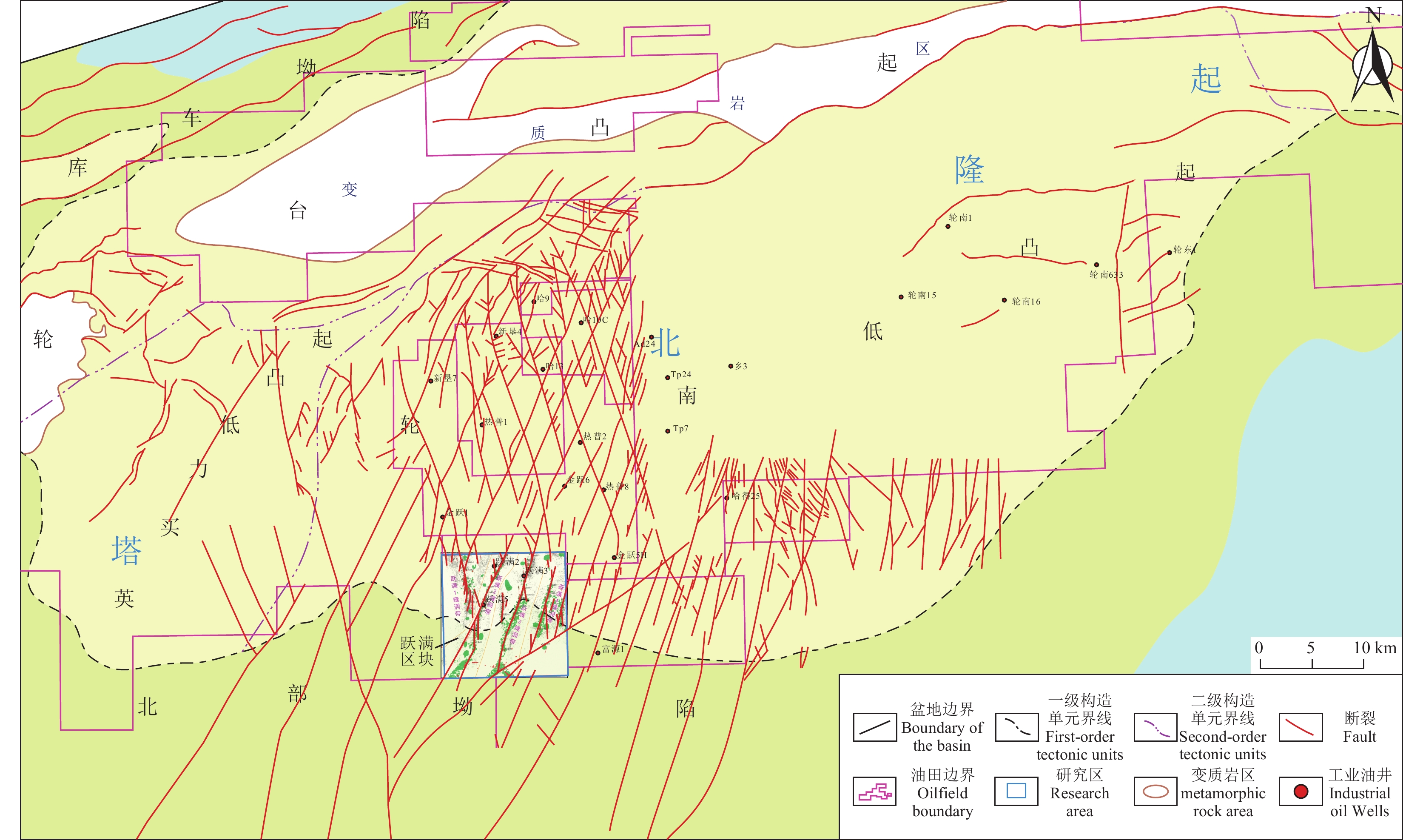
 下载:
下载:
